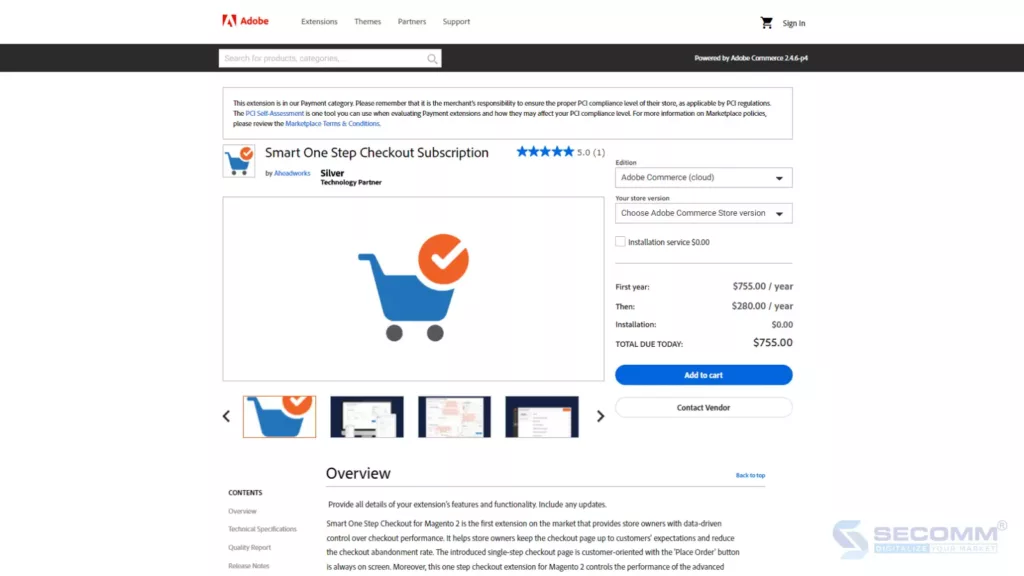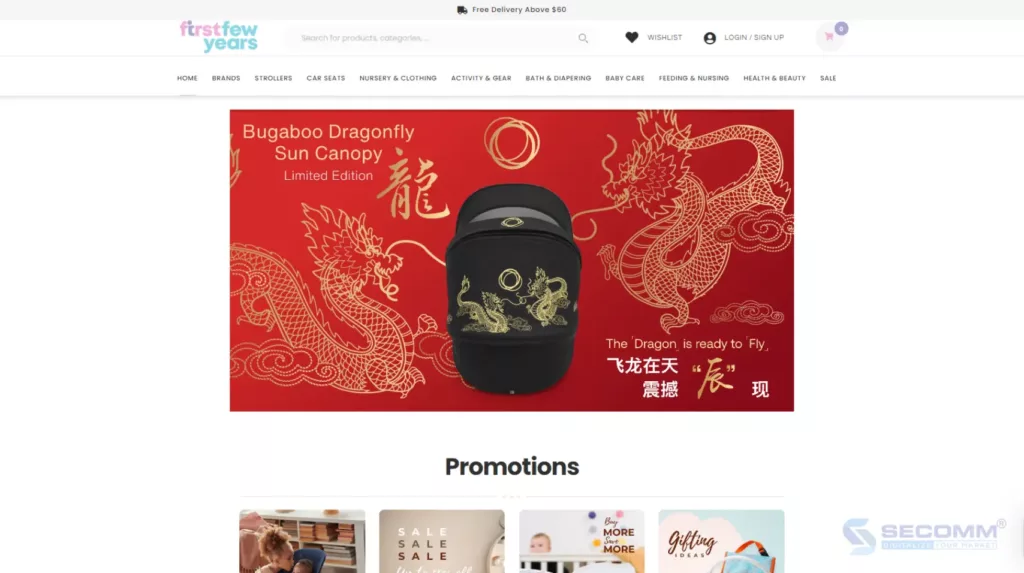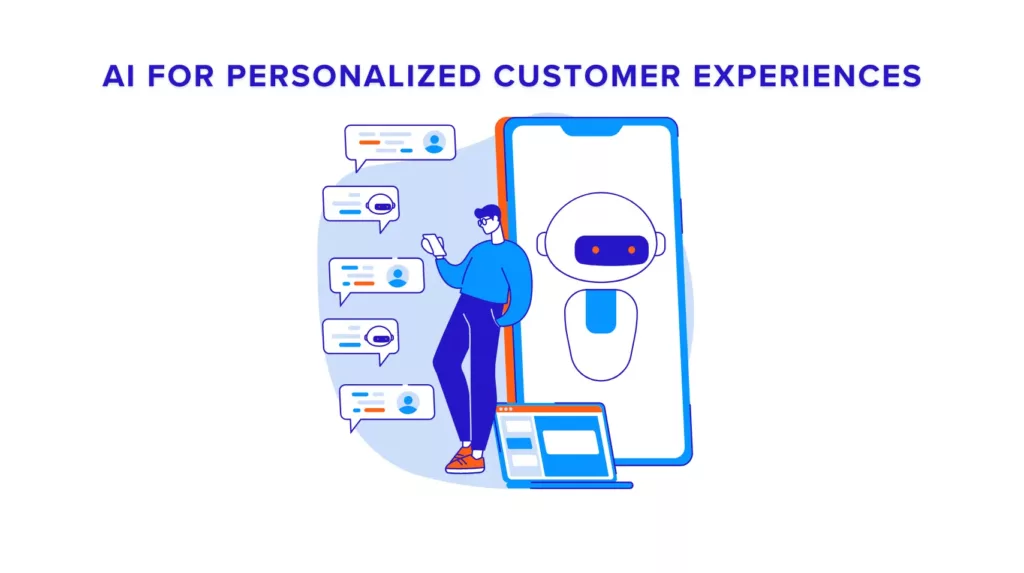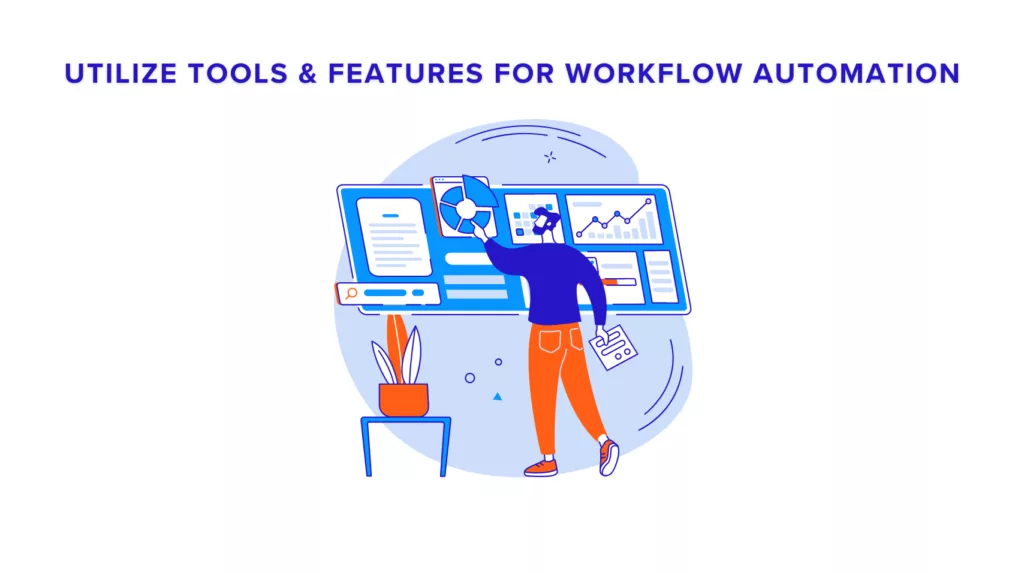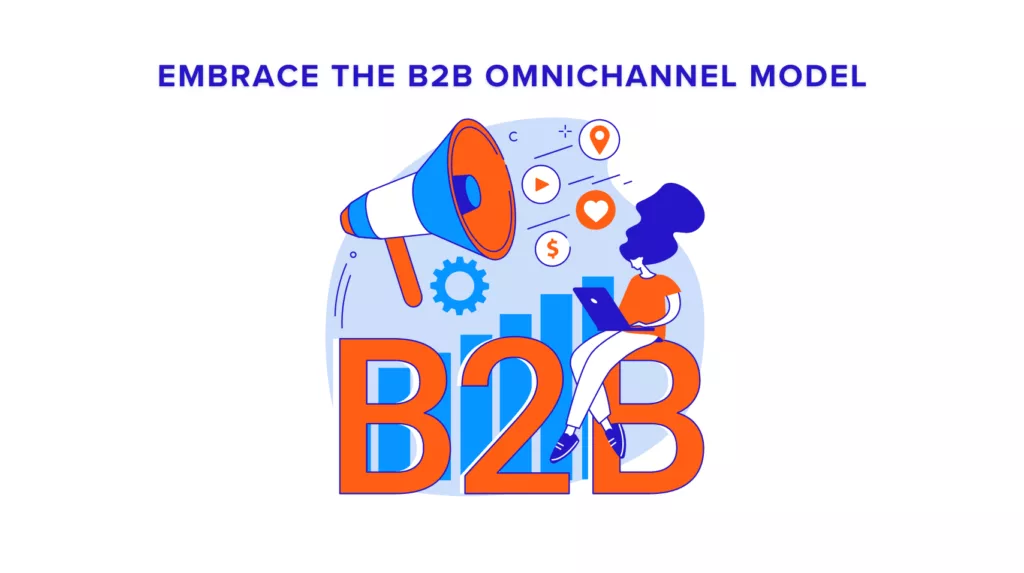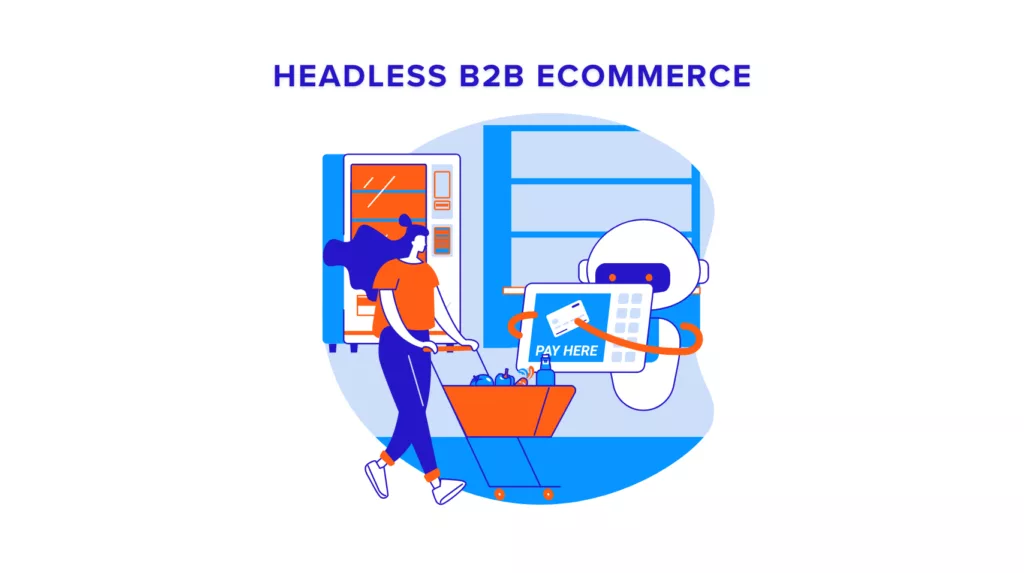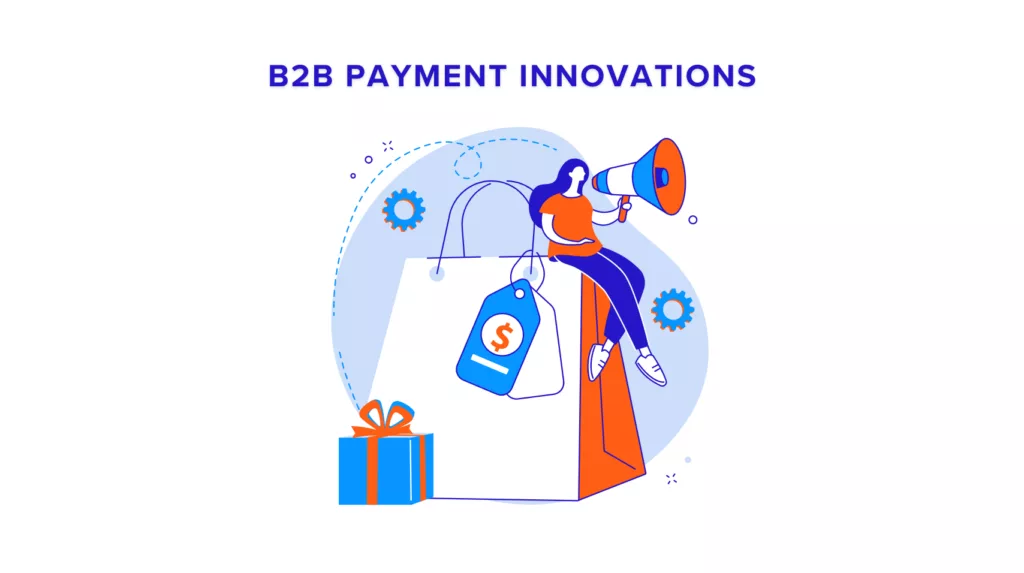It seems we can’t find what you’re looking for. Perhaps searching can help.




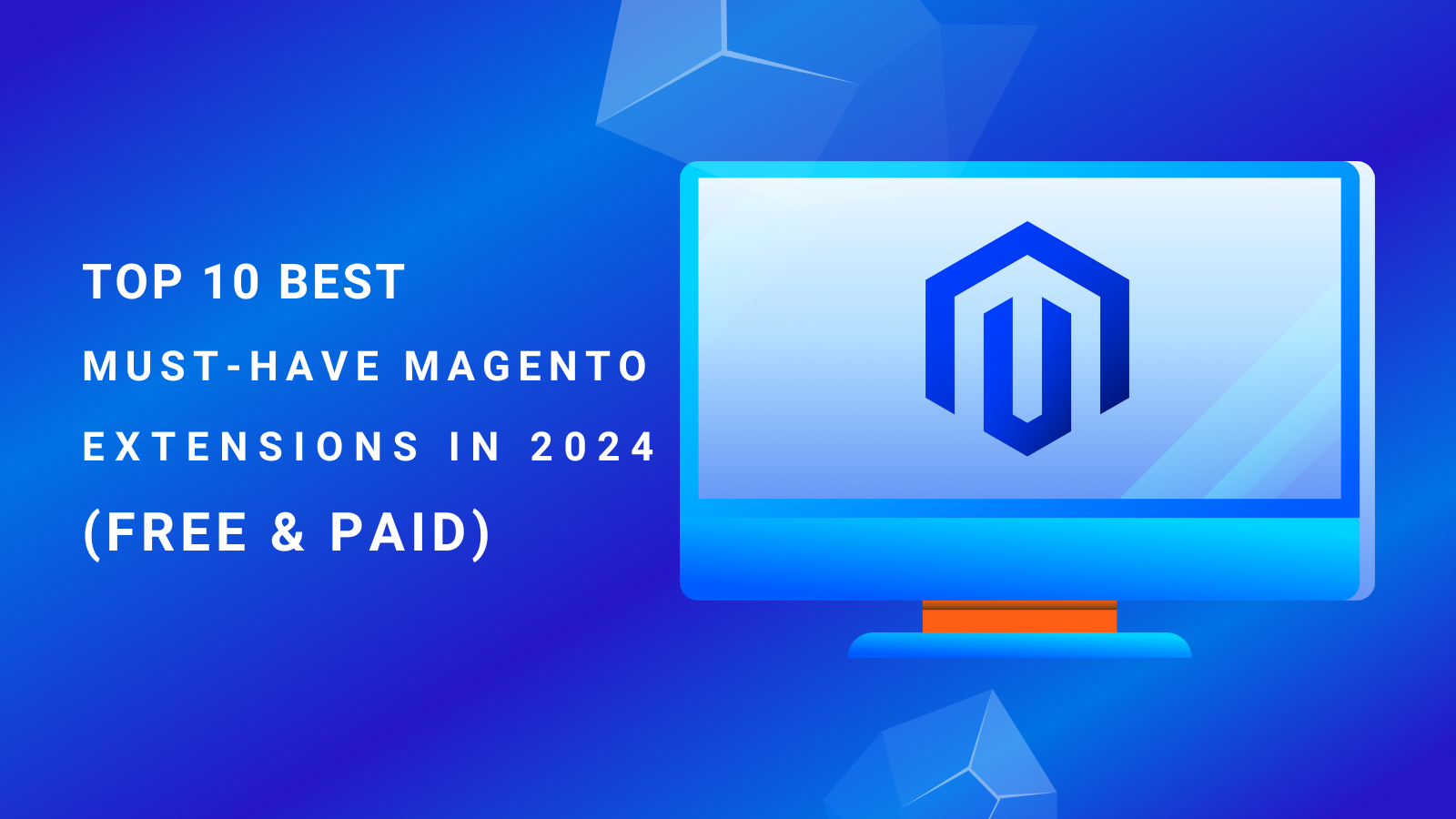
Top 10 Best Must-Have Magento Extensions in 2024 (Free & Paid)
Using Magento extensions isn’t just a trend; it’s a critical factor for the success of an eCommerce website. With the ever-growing market, delivering an optimized online shopping experience has become a must for attracting and retaining customers.
In this context, integrating best-suited Magento extensions into the website system will enhance performance, streamline management, and enrich customer engagement. Let’s explore the top 10 Magento extensions worth integrating to ensure your eCommerce website stands strong amidst fierce competition.
1. What are Magento extensions?
Before delving into the list of top Magento extensions, let’s gain a deeper understanding of this concept. Magento extensions are simply additional software integrated into the Magento platform to extend the functionality and capabilities of Magento websites. These extensions can provide new features, enhance user experience, optimize management, and upgrade core functions such as marketing, payments, shipping, and more.
These extensions are developed by the Magento community, including software development companies and eCommerce service providers. Most of them are available in both free and paid versions. While the free versions typically offer basic features, the paid versions often include advanced features and deeper support services.
2. Benefits of using Magento extensions
Choosing the right Magento extensions is a crucial part of building and managing a successful eCommerce website on the Magento platform. Let’s explore four benefits that using Magento extensions brings:
2.1 Extend functionality
Extensions help expand the functionality of Magento websites by adding new features and capabilities that the core system doesn’t provide. For example, businesses can integrate advanced search features to make it easier for customers to find products, add filters for customers to sort products based on various criteria, or integrate social features to encourage sharing and interaction on social media. As a result, Magento websites can offer a more engaging shopping experience, retaining and attracting more customers.
2.2 Optimize management
One of the significant challenges of managing eCommerce websites in general and Magento websites in particular is efficiently managing inventory, orders, and customer information. Magento extensions provide smart inventory management tools, user-friendly order management interfaces, and integration with customer relationship management (CRM) systems. Thus, businesses can save time and effort in managing daily business operations and focus on more critical development goals.
2.3 Enhance customer engagement
eCommerce websites are not just places for online shopping but also forums where customers can interact with each other and with the brand. Magento extensions offer interaction features such as product review and rating systems, loyalty points programs for loyal customers, and CRM software, helping businesses create a rich and engaging online shopping space.
2.4 Boost conversion rates
Lastly, using Magento extensions helps improve business performance by enhancing conversion rates, increasing sales revenue, and optimizing marketing strategies. Thanks to the flexibility and diversity of these extensions, businesses can customize and adjust their business strategies to meet market needs and achieve sustainable growth.
3. Top 10 leading Magento extensions
At the time of writing, the Magento platform offers over 4000 eCommerce extensions across a range of functions including marketing, payment processing, shipping, reporting, and analytics. Here are the top 10 most powerful extensions to consider adding to your Magento website:
3.1 Klaviyo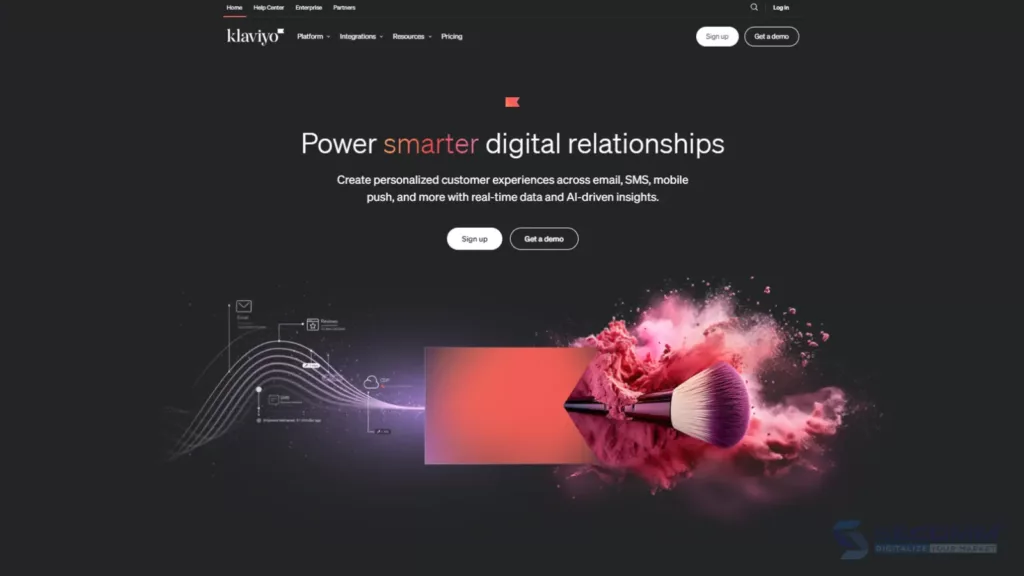
Klaviyo is a powerful tool for email and SMS marketing. With Klaviyo, businesses can create custom and automated email campaigns based on customer behavior, track performance, and interactions to optimize conversion rates and establish closer customer relationships.
Key features:
- Seamless integration with 300+ third-party systems. Top integrations with Klaviyo include Facebook, Trustpilot, Zendesk, Ordergroove, Stamped, and many more.
- Provides an easy-to-use email and SMS builder with customizable templates, allowing personalized form customization for each customer segment.
- Real-time data synchronization with Magento websites, including order data, cancellations, refunds, and order fulfillment for all customer segments
Pricing:
- Free version available
- Paid version: starts from $20/month depending on the number of email contacts.
3.2 HubSpot Contact Sync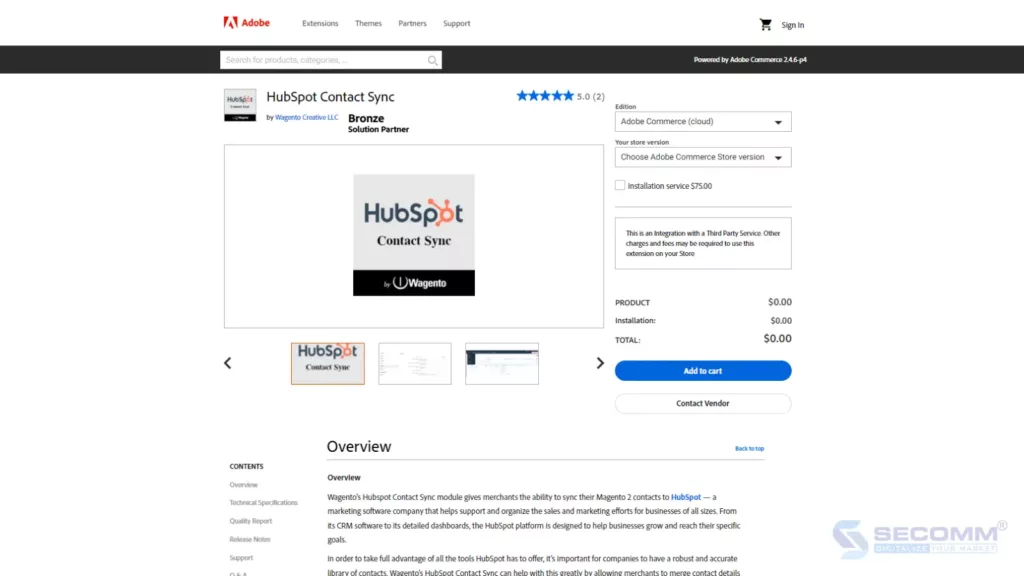
This extension integrates Magento with HubSpot CRM, allowing businesses to automatically synchronize customer information between the two platforms. This facilitates more efficient tracking and management of customer information and enables optimized marketing campaigns.
Key features:
- Synchronize new customer data registered on the Magento website to HubSpot
- Synchronize newsletter subscriber data from the Magento website to HubSpot
- Synchronize previously existing data to the HubSpot system
- Be compatible with Magento Open Source and Magento Commerce
Pricing: Free to use
3.3 LiveChat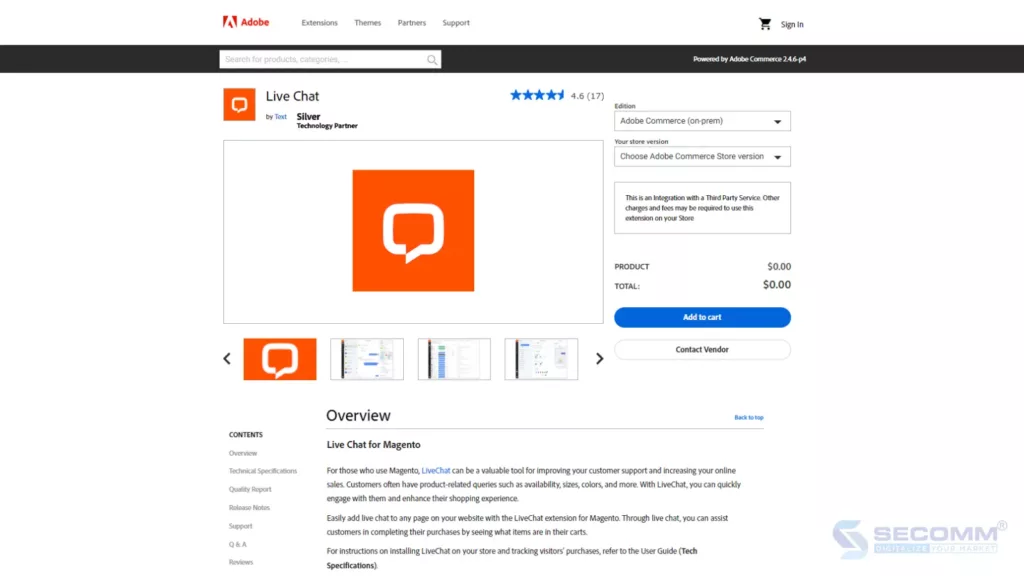
LiveChat is a powerful online customer care solution for Magento. LiveChat helps businesses enhance interaction and provide quick and professional support. This helps businesses improve the shopping experience for customers and increase conversion rates.
Key features:
- Ability to send personalized messages to website visitors on Magento
- Enable cart tracking while chatting with customers.
- Improve the efficiency of customer service by conducting multiple chat sessions simultaneously
- Seamless integration with third-party systems: Zendesk, Messenger, HubSpot CRM, WhatsApp, Mailchimp, Salesforce, etc.
Pricing:
- Free version: allows for a 14-day free trial
- Paid version: starts from $20/month
3.4 eDesk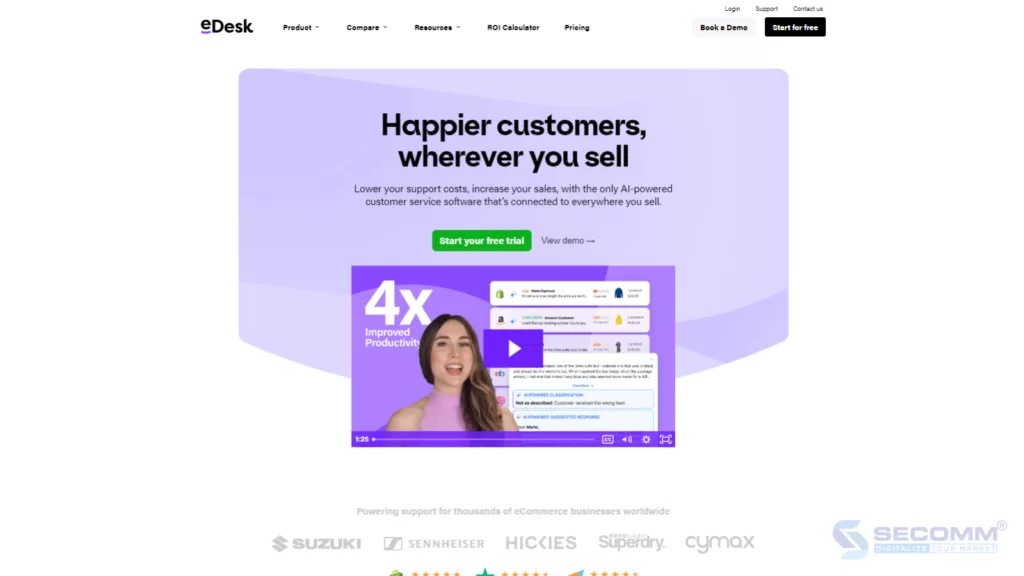
eDesk is a preferred centralized customer service and support management platform by many Magento businesses. This tool helps efficiently manage and respond to customer inquiries in an automated manner. This improves the efficiency of customer service teams and enhances customer satisfaction.
Key features:
- Providing a unified inbox and allowing centralized management of all support channels
- Segmenting customers based on products, order history, and lifetime value
- Integrating automated response features
- Responding to customers faster with pre-made templates
- Personalizing customer service with a 360° view feature
Pricing:
- Free version available
- Paid version: starts from $69/month
3.5 Payment services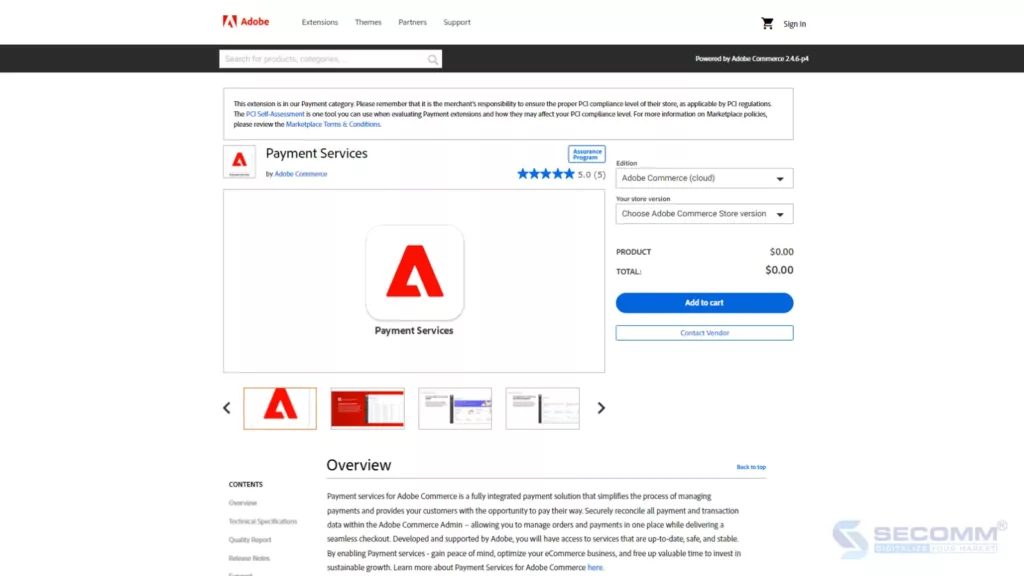
This is an Adobe Commerce extension that simplifies the payment process for businesses and allows customers to pay for orders the way they prefer. This extension ensures security for payment data and transactions, allowing admins to manage orders and payments in one central location while still providing a seamless payment experience.
Key features:
- Deployment of multiple payment methods including debit cards, credit cards, PayPal, Venmo, Apple Pay, and Buy Now Pay Later
- Provides an integrated payment experience, where all transaction and payment data can be easily accessed in the Adobe Commerce admin interface
- Offers comprehensive reports on orders and payments on the Magento website, including detailed information on processed orders, payment balances, and transaction-level reports for financial reconciliation
Pricing: Free to use
3.6 Stripe payments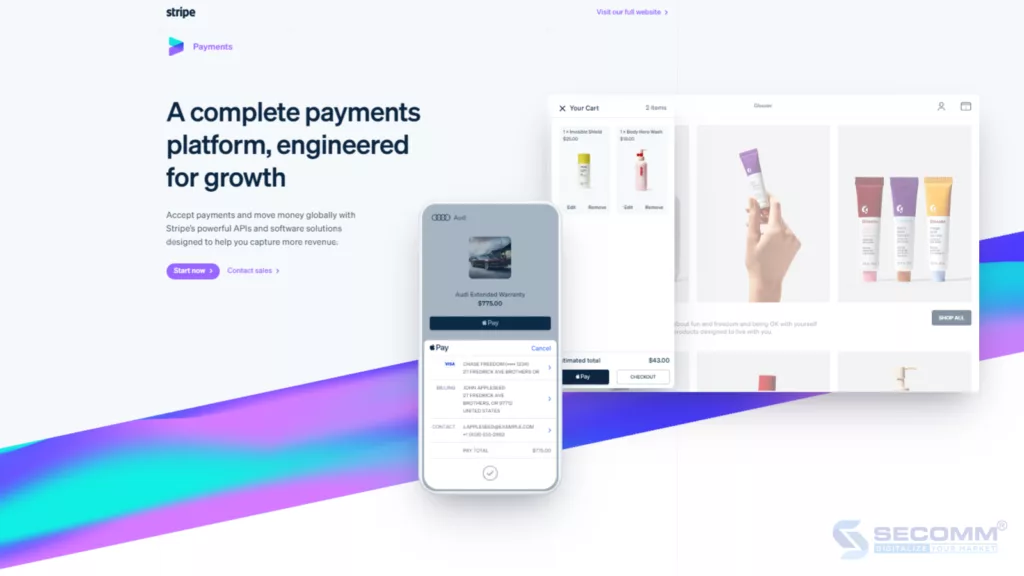
Stripe Payments is a prominent extension of the Magento platform, allowing for easy and secure online payment integration via Stripe, one of the leading payment gateways in the market. Stripe enables businesses to accept various forms of payment, providing convenience and flexibility for both customers and businesses.
Key features:
- Increase conversion rates by automatically adding payment information and shipping addresses.
- Automatically convert to the appropriate language, currency, and payment methods for each customer segment. As of the time of writing, Stripe supports over 25 languages, more than 135 currencies, and over 20 payment methods.
- Allow selling subscription packages on a weekly, monthly, or yearly basis, while supporting promotions and free trials to encourage subscription purchases.
- Handle refund processes, returns directly within the Magento Admin interface.
Pricing:
- No free version available
- Pricing structured for every business scale: 2.9% + 30¢ per successful transaction with local debit/credit cards.
3.7 Smart One-Step Checkout Subscription
This extension provides a quick and convenient payment experience for customers, helping to reduce the time and steps required to complete an order. This contributes to increasing order completion rates and reducing cart abandonment rates.
Key features:
- Allows for one-page checkout deployment
- Enables configuration of the checkout page based on the specific needs of each business
- Provides in-depth reports on the performance of the checkout page
Price:
- No free version available
- Free version: $13.99/month
3.8 ShipStation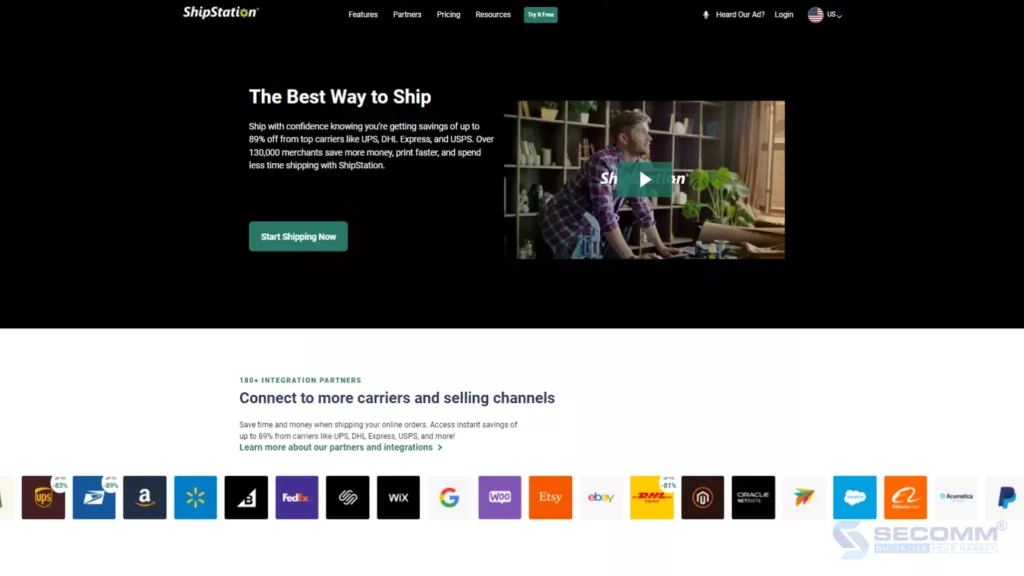
ShipStation is an integrated shipping platform that helps businesses easily manage and ship orders from various sources. By automatically integrating with leading carriers, businesses can save time and effort in processing and shipping orders.
Key features:
- Automated synchronization and centralized management of order data from various sales channels: Magento website, offline stores, Amazon, eBay, Walmart, and Alibaba.com
- Streamlines the order fulfillment process, automating the selection of shipping service providers
- Supports integration with a variety of carriers
- Allows printing of hundreds of shipping labels with just a few clicks
- Provides marketing tools such as branded order tracking pages, custom confirmation emails, branded stickers, and custom packing slips to enhance the customer experience.
Pricing:
- No free version available
- Paid version: starts from $9.99/month
3.9 Google Tag Manager & Analytics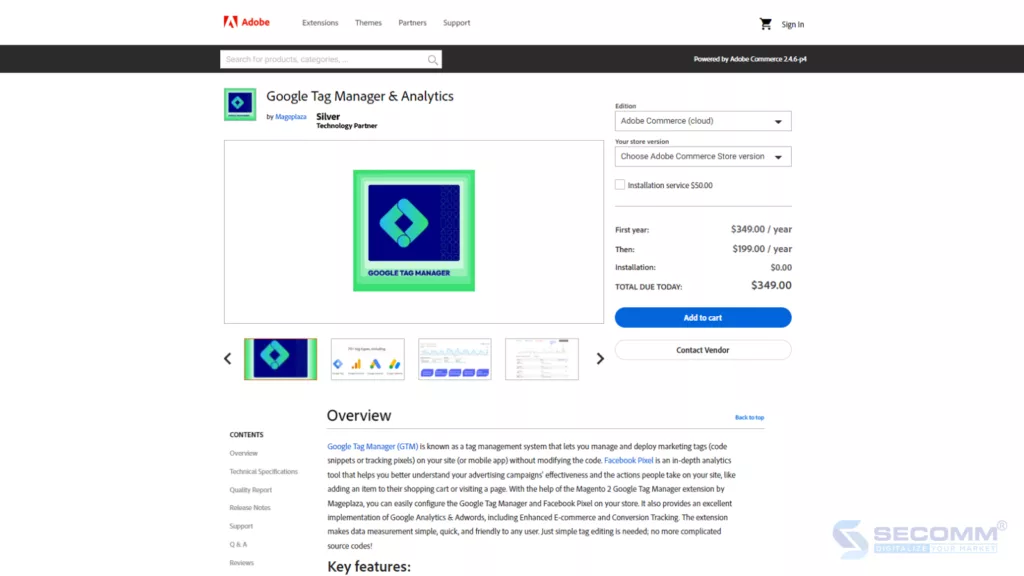
One of the noteworthy Magento extensions to consider integrating is Google Tag Manager & Analytics. This is a Google management and analytics tool that seamlessly integrates with the Magento website system, allowing businesses to track and analyze customer behavior on the website more effectively. With this extension, businesses can easily manage tags and track the performance of marketing campaigns.
Key features:
- Simplifying the tag management process
- Supporting remarketing strategies
- Seamless integration with Google Analytics. Providing detailed reports on purchase behavior, payment behavior, sales performance, etc.
- Seamless integration with Facebook Pixel, allowing businesses to track conversion rates to enhance sales funnel and marketing strategies.
Pricing:
- No free version available
- Paid version: $149 one-time payment
3.10 Reward Points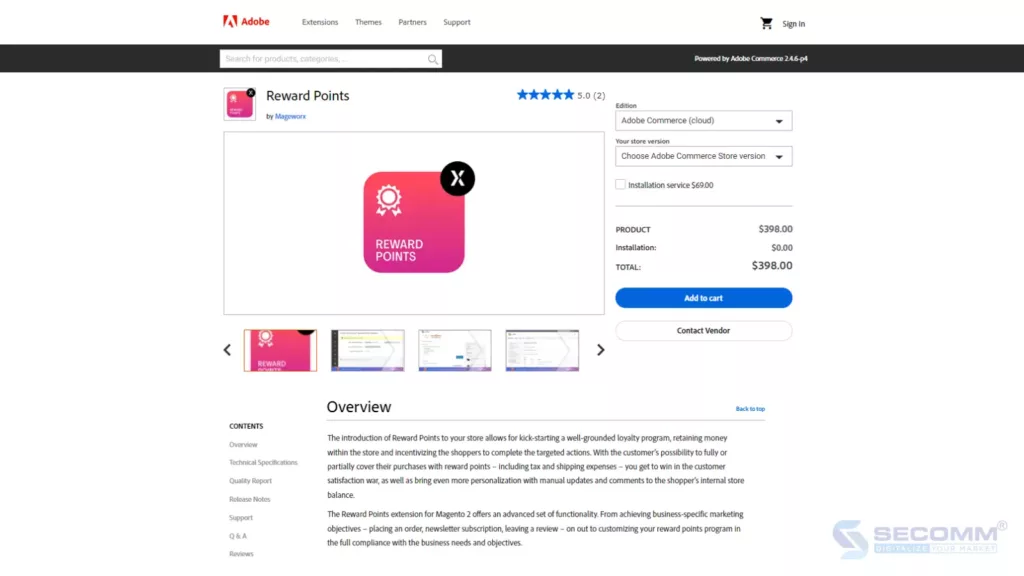
This extension allows businesses to create attractive reward point programs on the Magento website. This contributes to encouraging customer loyalty and increasing conversion rates. By providing rewards for every shopping action, customers are incentivized to return and shop more frequently.
Key features:
- Allowing the setup of rules and conditions for the point system
- Providing advanced options to efficiently manage loyalty programs
- Personalizing programs for specific customer segments
- Using CSV files to transfer reward point data between stores
Pricing:
- No free version available
- Paid version: $199 one-time payment
Final Words
Above are the 10 best Magento extensions, ranging from free options to paid solutions. Using extensions provides many opportunities to improve business performance and create the best shopping experience for customers.
Need advice on choosing the best-suited extensions for your Magento store? Contact SECOMM today!
 2
2

 74
74

 0
0

 1
1
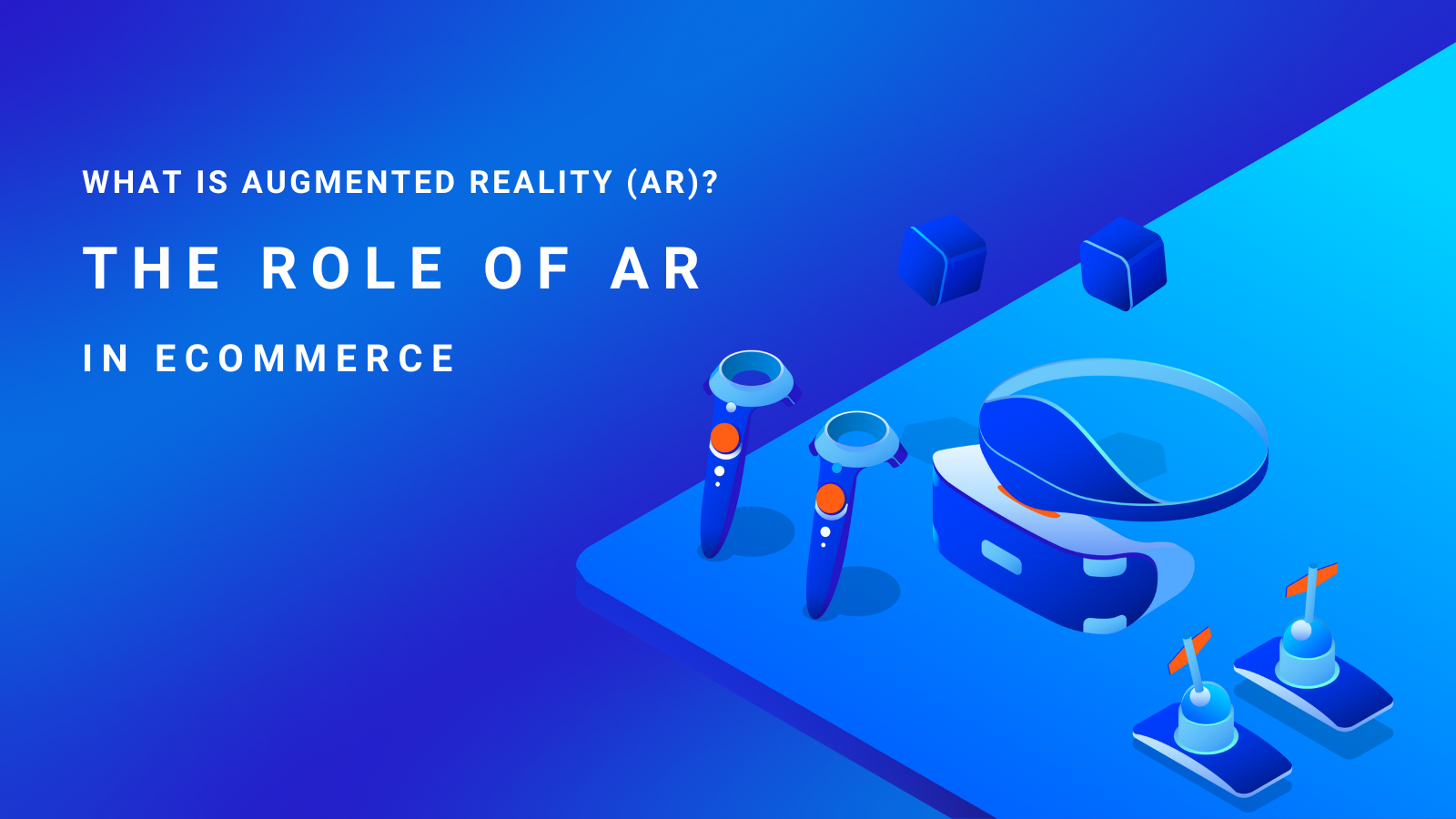
What is Augmented Reality (AR)? The Role of AR in eCommerce
Augmented Reality (AR) – a term that has become familiar in today’s technology world. From entertainment applications to various industries, AR is integral to our daily lives. Moreover, it offers engaging and distinctive interactive experiences for eCommerce consumers. But what exactly is AR? How does it differ from VR, and what is its important role for eCommerce businesses? Let’s explore through the following article.
1. What is Augmented Reality (AR)?
Augmented Reality (AR) is a technology brimming with potential, offering unique interactive experiences by merging real-world elements with computer-generated virtual elements. Simply put, AR allows users to “augment” the real world by adding information or virtual objects to it. This can occur via the screen of a mobile device, AR glasses or wearable devices.
One of the distinctive features of AR is its ability to create engaging interactive experiences for users without disconnecting them from the real world. Instead of separating users from their surroundings, AR serves as a bridge, seamlessly blending the virtual world and the real world together in a natural manner.
Continuously evolving, AR has progressed beyond being solely used in entertainment, opening up new possibilities in fields such as education, healthcare, advertising, and particularly eCommerce.
2. Augmented Reality (AR) vs Virtual Reality (VR): What is the difference?
Although they can be easily confused, Augmented Reality (AR) and Virtual Reality (VR) are actually two distinct technologies with their use cases. While AR emphasizes “augmenting” the real world by adding virtual elements to it, VR brings users to an entirely new world, completely separate from the real world. When wearing VR headsets, users are fully immersed in a virtual environment, no longer seeing or interacting with the real world around them.
Simply put, AR combines the real and virtual worlds, whereas VR completely transitions users into a virtual realm. This difference is also reflected in how AR and VR are used in different contexts. While VR is often used in entertainment fields such as video games and films, AR can be integrated into practical applications like repair guides, online shopping, and much more.
3. Four types of Augmented Reality in eCommerce
In the eCommerce world, various types of AR are used to create engaging interactive experiences for customers. Here are the four most common types:
3.1 Marker-Based AR
This type of AR uses markers or recognizable images to trigger and display virtual objects. Markers can be images, symbols, or QR codes. When the camera or AR device detects the marker, virtual objects appear on the screen, aligned with the position and orientation of the marker.
3.2 Markerless AR
Unlike Marker-based AR, this type doesn’t require markers to determine the position and display virtual objects. Instead, it employs technologies such as image recognition, and GPS localization to determine the user’s position and direction, and then displays corresponding virtual objects on the screen.
3.3 Projection-Based AR
This type of AR utilizes image projection devices to directly display virtual objects onto real surfaces. Instead of using a phone screen or AR glasses, AR objects are projected onto walls, screens, or other surfaces, creating the sensation that they exist in real space.
3.4 Overlay AR
This type of AR creates an experience by “overlaying” virtual objects onto the real world, similar to overlaying virtual information onto real-world images from a camera. AR objects can be interactive images, text, or 3D objects displayed on the screen of mobile devices.
4. Four benefits of adopting AR in eCommerce
Augmented Reality (AR) is not only an entertainment technology but also a powerful tool that enhances the online shopping experience and brings clear benefits to eCommerce businesses. Here are four main advantages of implementing AR in eCommerce:
4.1 Enhance the shopping experience
AR technology provides customers with a highly interactive and engaging shopping experience by allowing them to “try on” products in a real-world environment before making a purchase. With AR, customers can view products from various angles, change colors and sizes, and even test out product features or functionalities visually, enabling them to make quicker and more accurate purchasing decisions.
4.2 Boost customer interaction
AR in eCommerce captivates customer attention by introducing novel and unique shopping experiences, encouraging them to interact more with the brand. Being able to interact with virtual products on mobile screens or AR glasses makes the shopping process more enjoyable, and the ability to share this experience on social media creates a positive ripple effect for the brand.
4.3 Reduce return rates
One major issue that eCommerce businesses face is the rate of product returns. AR technology can help minimize this rate by providing customers with an accurate and detailed view of products before purchase, thereby reducing the likelihood of products being returned due to incorrect size, color, or quality.
4.4 Improve marketing efficiency
AR technology can be an effective marketing and advertising tool, enabling businesses to create powerful interactive content. Incorporating AR into marketing strategies not only helps increase brand awareness and attract new potential customers but also reinforces the loyalty of existing customers.
5. Three ways to embrace Augmented Reality (AR) in eCommerce
The use cases of AR in eCommerce are diverse and extensive. However, three primary methods stand out as the most common and favored by brands aiming to bolster customer interaction and increase sales.
5.1 Virtual Try On
One of the most popular applications of AR in eCommerce is creating a “virtual try-on” experience for customers. Instead of visiting stores to try on clothes, customers can use AR on their mobile devices to see how products look on-screen. Products that can utilize Virtual Try On include clothing, cosmetics, watches, eyeglasses, etc. Therefore, many brands worldwide have adopted this approach, such as Sephora, Bon Look, and Kylie Cosmetics.
5.2 Interactive Product Visualization
Some brands use AR technology to help customers visualize products more visually and vividly. For example, IKEA allows customers to “place” furniture products in real space through the IKEA Place app and rotate, zoom in, and zoom out to view every detail. Instead of just allowing customers to look at static images, IKEA has provided a more engaging experience to encourage the decision-making process.
5.3 AR-Powered Marketing Campaigns
Some brands also leverage AR technology to create unique and impressive marketing campaigns. Coca-Cola launched an AR marketing campaign called #TakeATaste Now. This campaign allows customers to use mobile devices to scan QR codes on DOOH screens to change 3D images at will and receive a free bottle of Coca-Cola Zero Sugar. This has attracted curiosity and attention from the masses and successfully brought Coca-Cola Zero Sugar products closer to consumers.
Enjoy a free Coca-Cola Zero Sugar bottle with AR
Final Words
In summary, AR technology is not just a new trend but is also recognized as a powerful tool for optimizing eCommerce activities. With its superior flexibility, AR helps businesses build unique shopping experiences and create more engaging marketing campaigns to boost sales. You can find out more about B2B eCommerce trends here.
Ready to implement Augmented Reality (AR) in eCommerce? Contact SECOMM today!
 2
2

 152
152

 0
0

 1
1
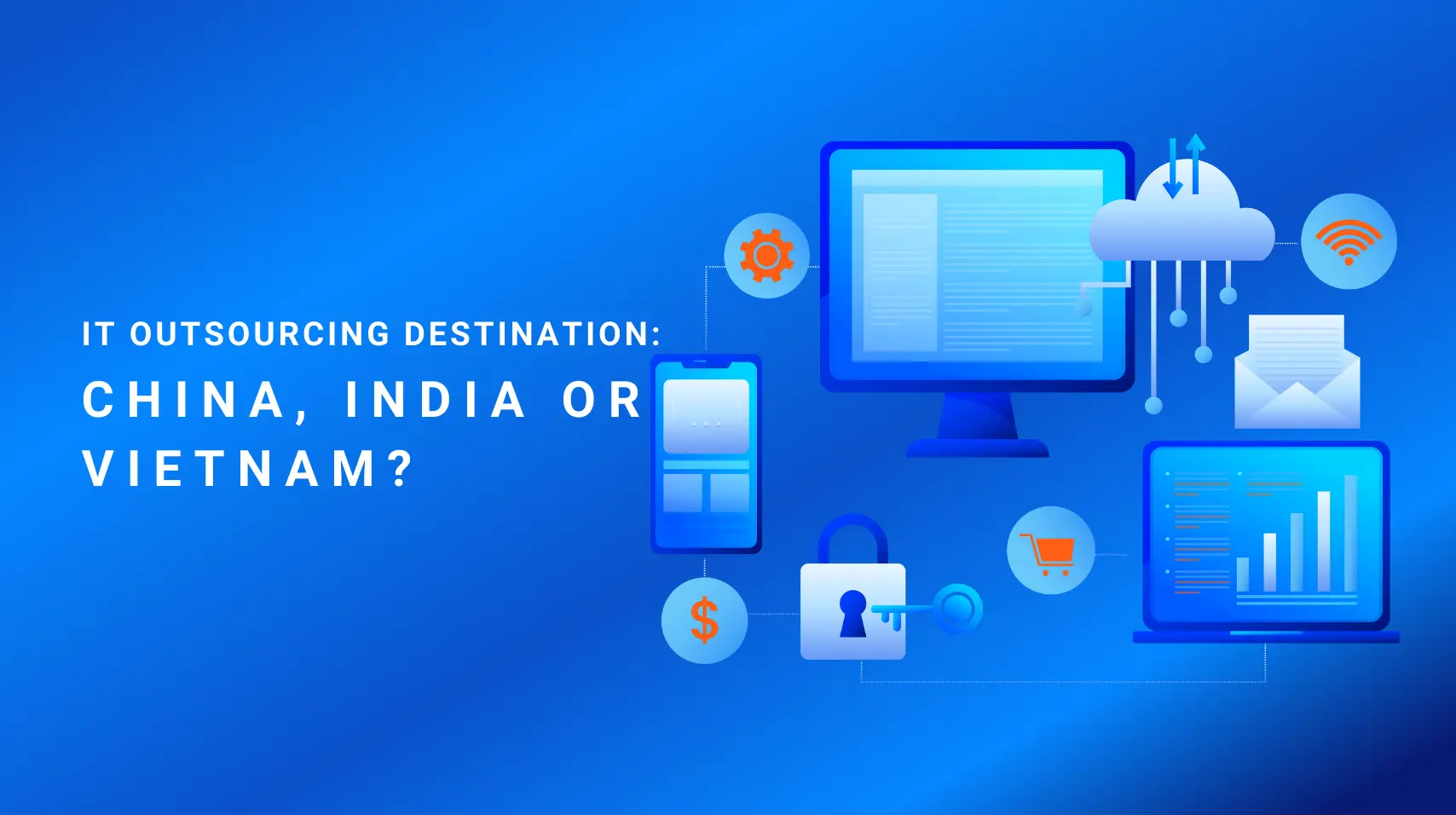
IT Outsourcing Destination: China, India Or Vietnam?
The IT Outsourcing market worldwide is projected to grow annually by 10.99%, reaching a market value of US$777.70 billion by 2028.
While India and China have long been the go-to nations for IT dedicated teams, new players like Vietnam are gaining ground. Companies have various choices based on language, cost, culture, and government support.
In this blog, SECOMM will explore the advantages and disadvantages of outsourcing IT functions to India, China, or Vietnam. This analysis will help companies make informed decisions about which country aligns best with their resources and strategic objectives.
1. Key Considerations for Choosing an IT Outsourcing Partner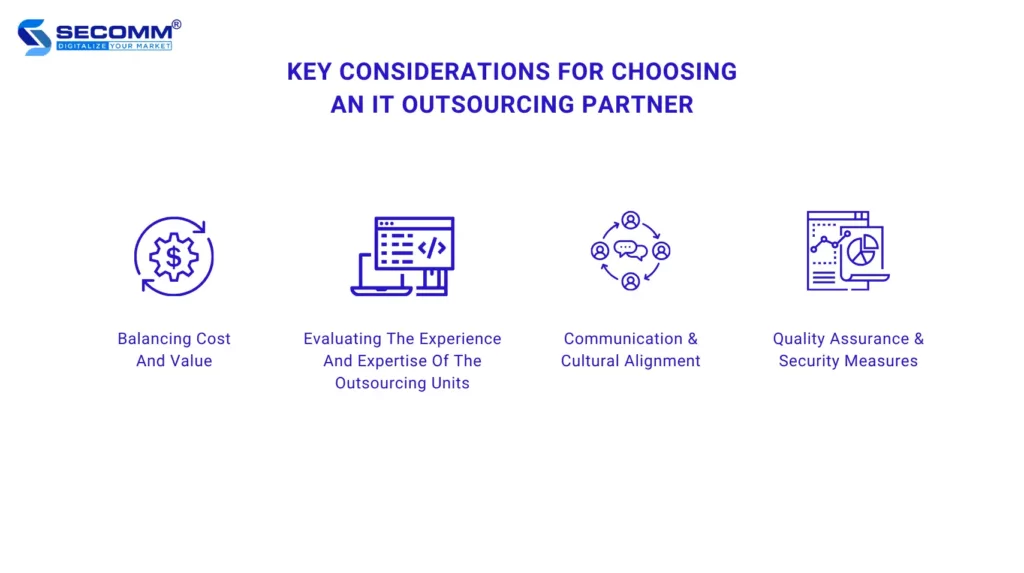
Before going further into the main points of the three countries, there are some key points that companies should be aware of when choosing an IT outsourcing partner.
1.1 Balancing Cost And Value
Selecting a partner who can provide both quality and competitive pricing is vital for the company’s campaign success. When assessing cost benefits, look beyond immediate savings. Consider the long-term expenses of communication, travel, staff turnover, and management tasks. These factors can impact your financial outcomes over time. For example, a company outsourcing to a country with low English proficiency may lead to communication challenges. To address this, the company might need to employ a local translator to ensure smooth operations.
1.2 Evaluating The Experience And Expertise Of The Outsourcing Units
A Deloitte study reveals that 59% of companies outsource software development for specialized skills and expertise. It’s important to choose partners known for providing skilled IT professionals and delivering projects akin to yours. Experience in similar projects or industries is a plus, as partners with relevant domain knowledge can offer valuable insights and tailored solutions. For example, in Vietnam, SECOMM is one of many companies proud of its ability to handle big projects globally easily due to its past experiences of working with many big names in the eCommerce industry.
1.3 Communication & Cultural Alignment
Cultural alignment and good communication are important but often ignored in outsourcing partnerships. Your partner should have values, work ethics, and communication methods similar to your company’s. Communication should be transparent and frequent throughout the project. Choosing a partner with staff who speak a language that both parties understand is important to avoid language barriers that could slow down progress.
1.4 Quality Assurance & Security Measures
Quality control is vital for software that’s free of bugs. Your outsourcing partner should follow the best practices in data security and software development. Quality assurance tests should be part of the development process to catch and fix issues early. Security is equally important for outsourced DevOps services. Check their security measures, data protection policies, and compliance with industry standards. They must protect sensitive data according to industry regulations and have clear methods for protecting intellectual property and confidential information.
2. Deep Dive into Each Country
2.1 China
Outsourcing to China is a strategic choice for many Western companies, largely due to the cost-effective services and access to a highly skilled workforce. China’s e-commerce market is the largest globally, and the country offers a stable economic environment, low corporate taxes, and numerous top-tier seaports. Moreover, China boasts one of the world’s largest and most proficient tech talent pools, adding to its appeal as an outsourcing hub.
A. Why Should You Choose China?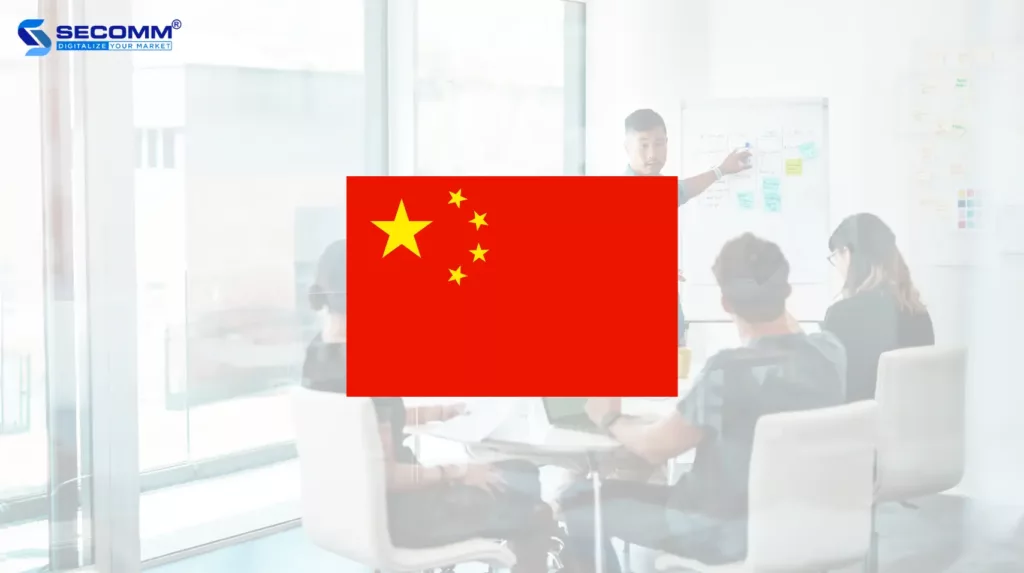
Inexpensive Workforce
Outsourcing IT to China offers clear financial benefits. Chinese developers provide services at competitive rates, which can lead to significant cost savings for businesses. This affordability doesn’t come at the expense of talent, as China has a large pool of skilled developers. The salaries for these developers are generally lower than in the US where Chinese professionals often charge around $50 to $100 an hour, with an average of around $29,840 a year.
Skilled Workforce
Moreover, China is a leading tech hub with one of the largest and most skilled IT dedicated teams in the world. By 2024, the global number of developers is expected to reach 28.7 million, with China contributing significantly to this growth. The country’s developer population is growing at a rate of 6% to 8%. China also prioritizes high-quality education, with 24 of its universities ranked among the top 200 worldwide. The Chinese government is actively launching educational initiatives to enhance technical skills, preparing its citizens for the evolving digital world.
Supportive Government Policies
The government invests in projects and infrastructure to aid these companies and streamline outsourcing. In 2020, China announced a massive $1.4 trillion investment to enhance public digital infrastructure. This investment is a boon for companies considering China for digital outsourcing, as it simplifies the integration of local talent.
B. Issues When Outsourcing To China
Additionally, there are still some issues that companies need to be aware of when contacting the IT dedicated team in China. Firstly, language barriers are significant when outsourcing to China, as not all IT professionals are proficient in English, potentially causing miscommunications and project delays. Cultural variances can also affect how communication is perceived and managed.
Additionally, on the topic of intellectual property, China’s laws may vary from those in other nations, posing a risk to the security of your ideas. Moreover, stringent data privacy and security regulations by the Chinese government can pose operational challenges for foreign IT service providers.
2.2 India
India has consistently been a dominant force in the global IT outsourcing sector, attributed to its extensive talent pool of IT experts and a favorable business ecosystem. The industry is projected to witness a compound annual growth rate (CAGR) of 17.58% between 2024 and 2028, culminating in a projected market value of USD 20.09 billion by 2028.
Clients within India’s IT outsourcing market demand cost-effective, high-caliber services. They seek partnerships with firms that offer comprehensive services, including software development, maintenance, and support, and value providers with industry-specific experience who can deliver solutions tailored to their precise needs. Additionally, India is ideal for businesses seeking experienced developers with strong communication skills for complex projects.
A. Why Should You Choose India?
Cost-Effective
Local outsourcing providers efficiently manage the entire process, including procurement, installation, and testing, ensuring a cost-effective and seamless experience. For example, establishing a website or developing a mobile application can be expensive, but outsourcing to India can reduce these costs by nearly 50%.
Furthermore, India’s lower living costs result in more affordable labor compared to countries like the United States. To illustrate, the average yearly salary for an IT employee based on Glassdoor in India is around $20,464, starkly contrasting the U.S. average of $109,829.
Large Labour Pool
The country’s diverse population contributes to a workforce that includes programmers, scientists, financial experts, MBAs, journalists, and virtual assistants with exceptional skills.
India’s government-funded higher education system is the third-largest globally, after the US and China. According to Statistica, India has over 6.5 million graduates each year, significantly more than the Philippines, which is a major competitor in the BPO and outsourcing sector.
B. Issues When Outsourcing To India
Communication
While Indians are proficient in English, the accent may sometimes lead to misunderstandings in verbal communication. It’s advisable to conduct most communication in writing, through emails and chats, to reduce miscommunication risks and maintain a written record for reference if needed.
Privacy And Security Legislation
In software development and IT, the risk of intellectual property (IP) being copied is significant. Without proper safeguards, there’s no guarantee of protection, as projects might be resold.
To protect your interests, it’s wise to sign an NDA with your outsourcing partner. Be careful with IP issues and consider getting legal advice for big projects with substantial financial stakes.
2.3 Vietnam
Vietnam has gained prominence in the IT outsourcing industry over the last ten years. It’s now a significant force globally, with a focus on software development, digital content, and BPO. The growth of Vietnam’s IT outsourcing sector is attributed to its youthful, talented workforce, competitive labor costs, and supportive government policies. Plus, its strategic position in Southeast Asia adds to its appeal as an outsourcing hub for regional and international businesses.
A. Why Should You Choose Vietnam?
Cost-Effectiveness
Outsourcing to Vietnam offers a key benefit: access to skilled tech talent at affordable rates. Vietnam, located in one of the world’s most cost-effective regions, has leveraged this to become the 6th top destination for software development. In 2022, Vietnam was rated 99.6/100 for low manufacturing costs by US NEWS and is among the lowest in Asia.
This results in significantly reduced IT outsourcing costs compared to other countries. For instance, the average annual income for a developer in Vietnam is approximately $7, 173, which is the lowest among the three. This represents a cost reduction of up to 94% compared to the US, 65% compared to India, and 76% compared to China.
Qualified IT Human Resources
Vietnam’s pool of highly educated and tech-savvy young professionals, many of whom have studied or worked abroad, makes it an attractive destination for outsourcing. Additionally, Vietnam offers technical training in various programming languages through its universities and technical schools, producing around 400,000 IT engineering graduates and 50,000 IT students annually.
Overall, Vietnam is well-equipped to meet the skilled workforce demands of employers seeking outsourcing opportunities, with a lower turnover rate compared to other countries in the field. Companies in Vietnam experience an IT-related turnover rate of less than 5%, making it an appealing choice for businesses.
Capable Of Working With The Giants
Major multinational companies and tech giants, including Intel and Microsoft, have established a strong presence in Vietnam by outsourcing software development and IT support services. Additionally, other firms like IBM, Cisco, and Bayer are also expanding their IT roles in Vietnam.
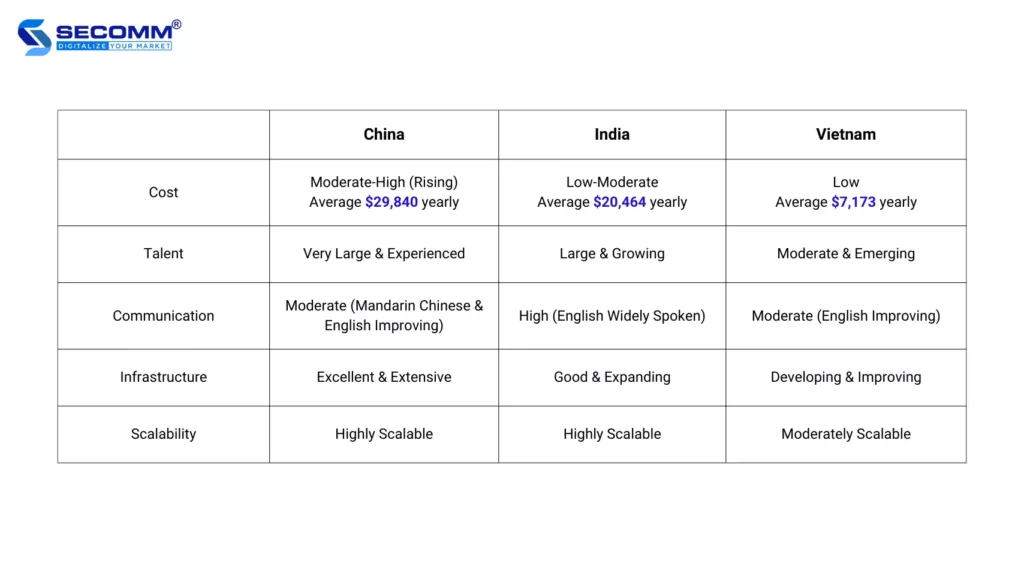
The involvement of these esteemed organizations serves as a testament to Vietnam’s adeptness in managing substantial outsourced or offshore software development initiatives, despite its status as a relatively small emerging nation in contrast to larger, more developed counterparts such as India and China.
3. Choosing the Right Partner!
Overall, China’s large, albeit aging, labor force and developed infrastructure are offset by rising costs and regulatory concerns. While India shines with its vast, young talent pool, cost-effectiveness, and robust infrastructure, making it a strong contender for scalability and quality. Finally, Vietnam emerges as a compelling choice with its youthful, tech-savvy workforce, competitive costs, and rapidly improving infrastructure.
Read more: IT Outsourcing in Vietnam: Benefits and Challenges
SECOMM stands out with over a decade of experience for organizations seeking a reliable IT-dedicated team in Vietnam. Engaging with SECOMM means your IT projects are in the hands of exceptional talent, driving innovation and advancing your business objectives. To explore a partnership with SECOMM, reach out or dial the hotline at (+84) 28 7108 9908 for a collaboration that can elevate your IT capabilities.
 10
10

 234
234

 0
0

 1
1
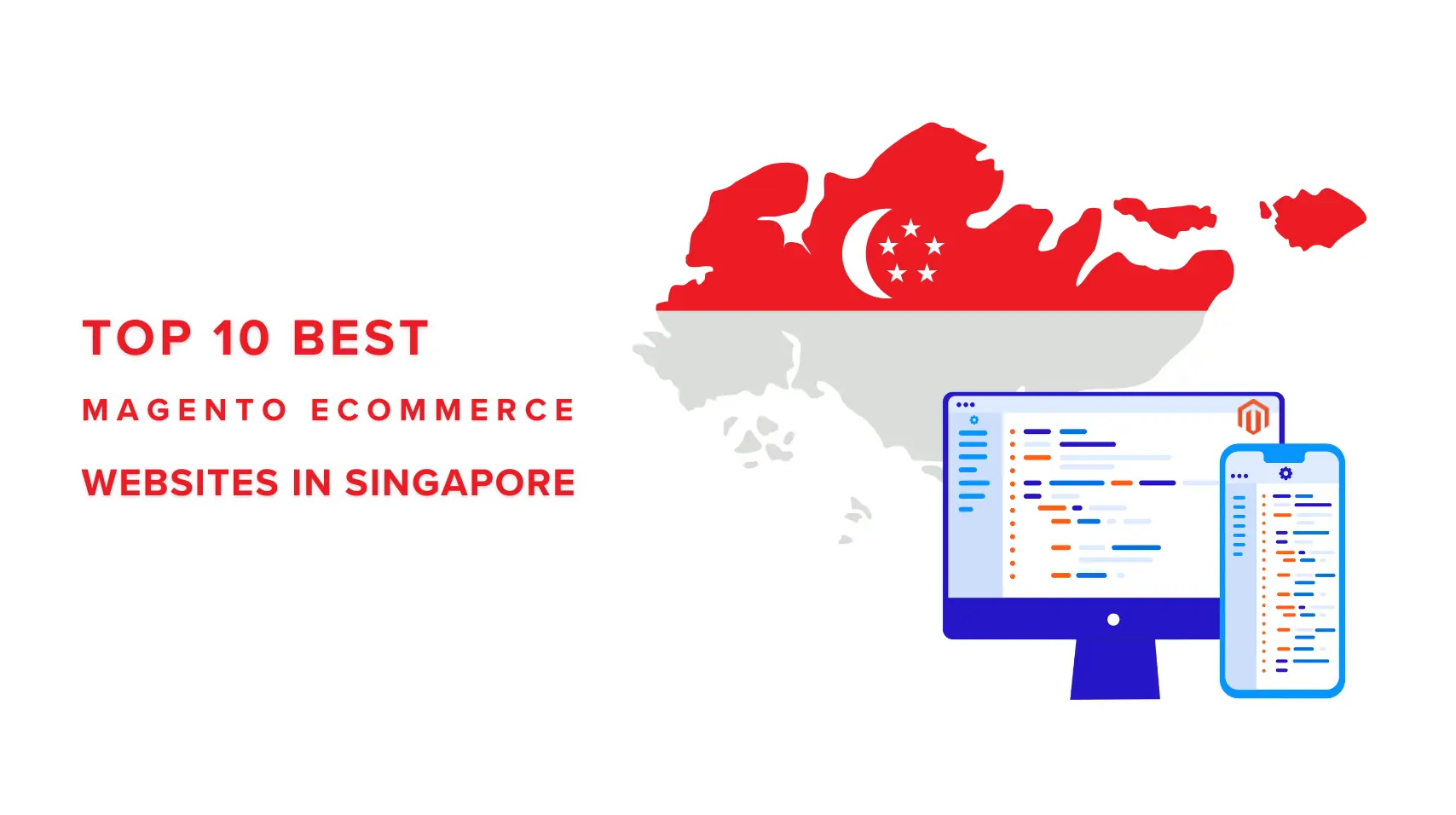
Top 10 Best Magento eCommerce Websites In Singapore
Building Magento eCommerce websites has become an undeniable trend in Singapore, where the blend of technology and creativity has brought unique and appealing shopping experiences to customers. According to Builtwith, there are currently over 600 live eCommerce websites on the Magento platform, and this list is predicted to continue expanding. This indicates that businesses in the Lion City have chosen Magento to create high-quality eCommerce websites, attracting customers and boosting sales.
In this article, let’s explore the top 10 Magento websites in Singapore that have leveraged the power of Magento to enhance the customer experience.
1. Dyson Singapore
Dyson Singapore is not just an ordinary eCommerce website but also a destination for technology and premium design enthusiasts. With a range of products from vacuum cleaners to smart fans and hair dryers, Dyson continually innovates and enhances the quality of consumers’ lives.
Dyson’s Magento website is designed to provide an optimal shopping experience. From its bright and user-friendly interface to smart product search and categorization features, every detail is carefully crafted to ensure customers have the best online shopping experience. Additionally, Dyson is renowned for its excellent customer care service. From detailed product guidance to flexible return policies, they are committed to ensuring absolute satisfaction for every customer.
Website: https://www.dyson.com.sg/
Industry: Consumer Electronics
Traffic: 690,356/month
Ranking: #1,599 (Singapore) & #292,561 (Global)
2. FortyTwo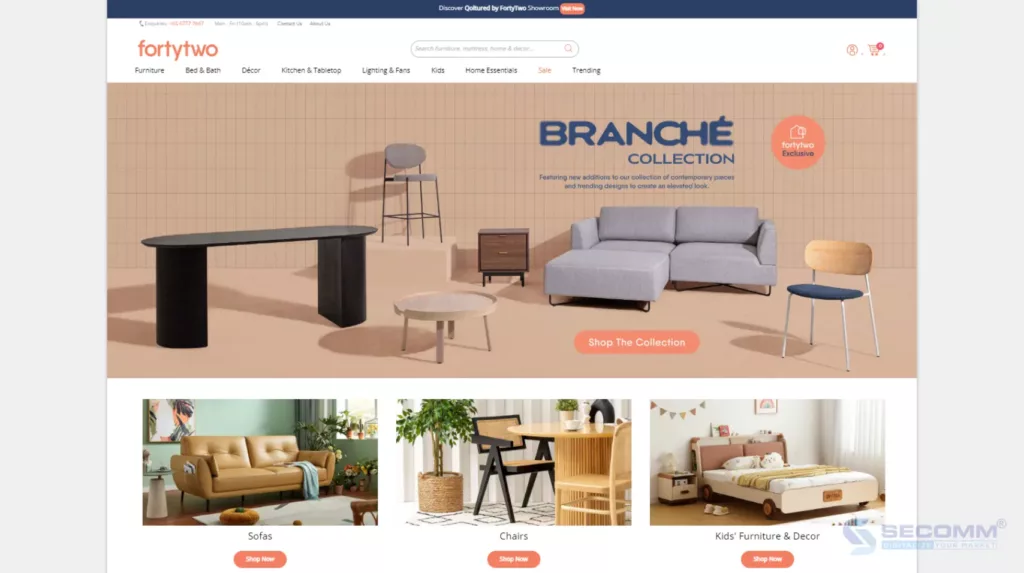
FortyTwo is one of the reputable destinations for household and interior decoration shopping in Singapore. With a diverse collection ranging from living room furniture, bedroom sets to household essentials, FortyTwo offers customers a convenient and varied online shopping experience.
FortyTwo’s eCommerce website is built on the Magento platform, focusing on creating a user-friendly interface. Not only does it display products clearly, but it also provides flexible product search and filtering features, making it easy for customers to find items that reflect their style and personal needs.
Website: https://www.fortytwo.sg/
Industry: Furniture
Traffic: 625,855/month
Ranking: #493 (Singapore) & #107,563 (Global)
3. COURTS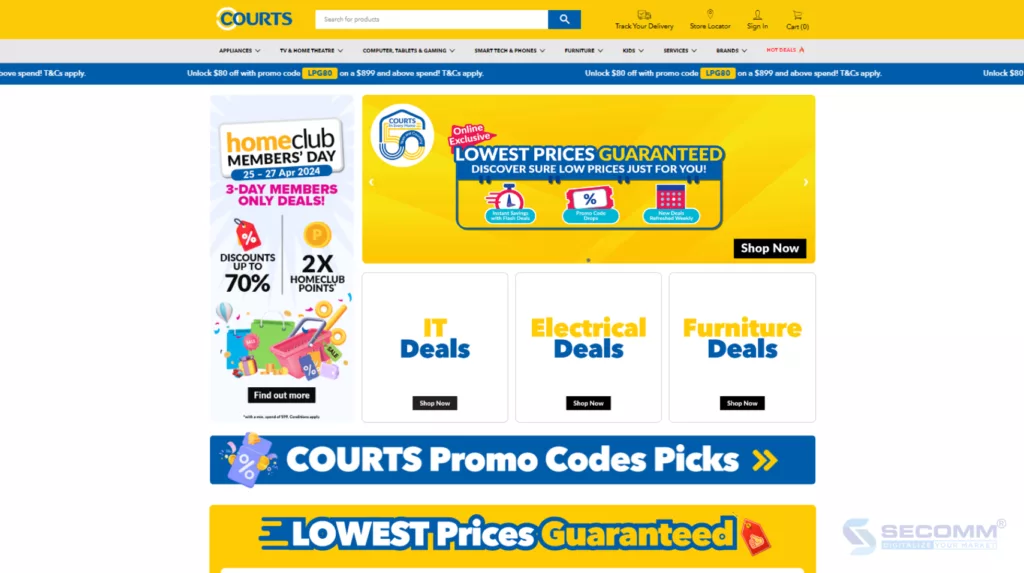
COURTS is known as the leading retailer in Singapore, specializing in a range of diverse products from furniture, electronics to household services. With over 14 stores across the island and a convenient e-commerce website, COURTS is the ideal destination for all shopping needs of Singaporean families.
COURTS’ Magento eCommerce website is designed and built to ensure an easy and comfortable online shopping experience. Through the Magento website, COURTS customers can easily search and select from a variety of high-quality products with flexible search and sorting features.
The brand stands out not only with its diverse products but also with its professional customer service. From shopping advice to delivery and installation services, they are committed to providing maximum satisfaction for every customer.
Website: https://www.courts.com.sg/
Industry: Consumer Electronics
Traffic: 510,240/month
Ranking: #502 (Singapore) & #105,498 (Global)
4. Horny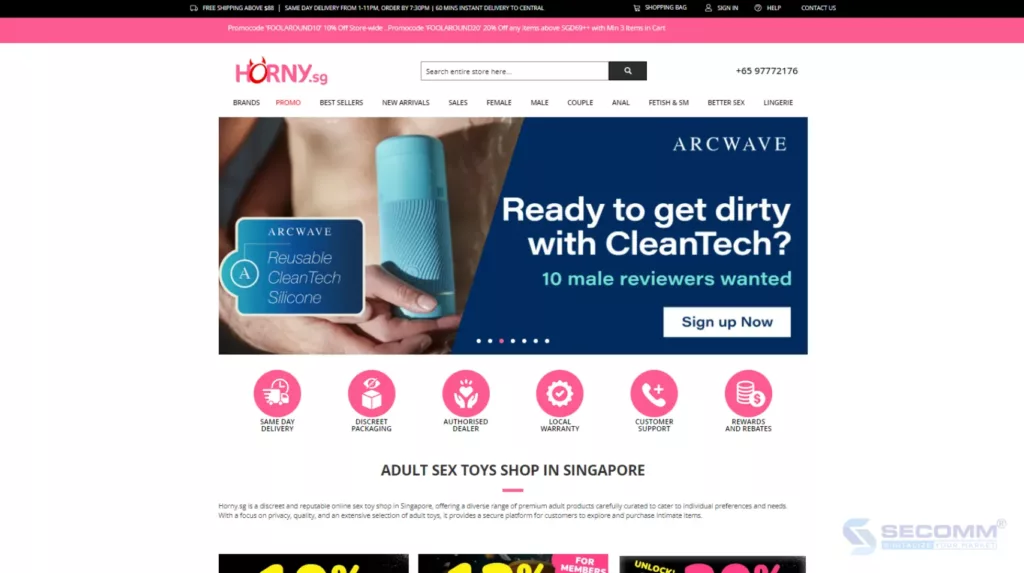
Horny is a unique eCommerce website based in Singapore, focusing on providing modern adult accessories. With a mission to help customers feel confident and satisfied in their romantic lives, Horny has created an enjoyable and convenient shopping experience through the Magento platform. Horny’s Magento eCommerce website is built with a focus on creating a reliable and user-friendly online shopping space. From attractive interface layouts to clear and detailed product displays, every detail is meticulously crafted to create the best shopping experience. Additionally, Horny stands out with the diversity of fashion and accessory products. Customers can easily find items that suit their individual needs.
Website: https://horny.sg/
Industry: Adult
Traffic: 482,417/month
Ranking: #1,133 (Singapore) & #193,753 (Global)
5. Saturday Club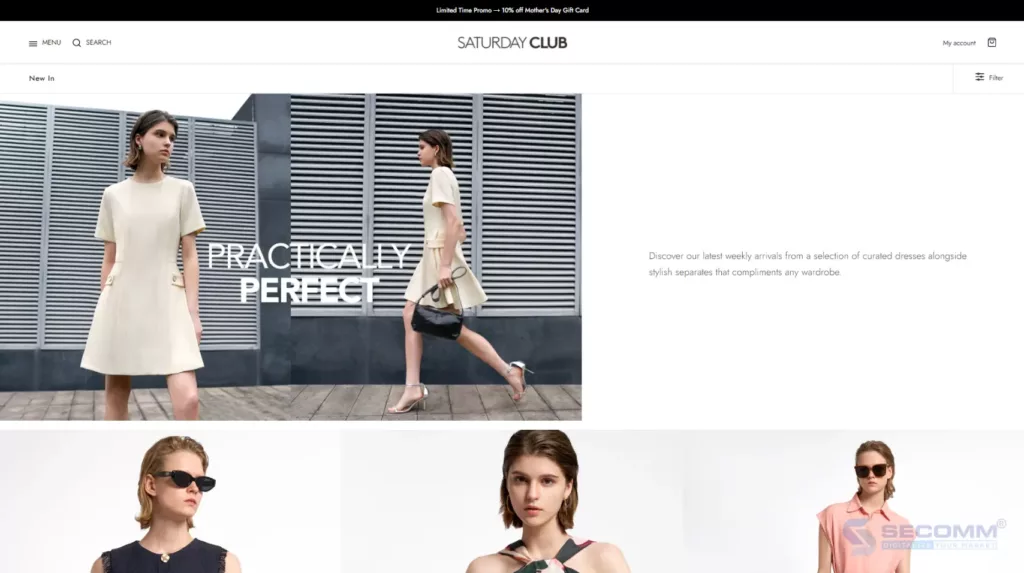
Saturday Club is not just a fashion brand but also an icon of confidence and freedom in women’s workwear fashion in Singapore. With a creative spirit and a mission to celebrate natural beauty, Saturday Club continuously brings fresh, stylish, and unique fashion collections.
Saturday Club uses Magento to develop its eCommerce website to provide customers with a smooth shopping experience with an easy-to-use interface. Customers can easily choose from a variety of products and the latest collections, with detailed information and clear images. Additionally, the brand stands out with attentive customer care service and fast and flexible delivery policies.
Website: https://sg.saturdayclub.com/
Industry: Fashion
Traffic: 406,335/month
Ranking: #2,115 (Singapore) & #240,670 (Global)
6. Pupsik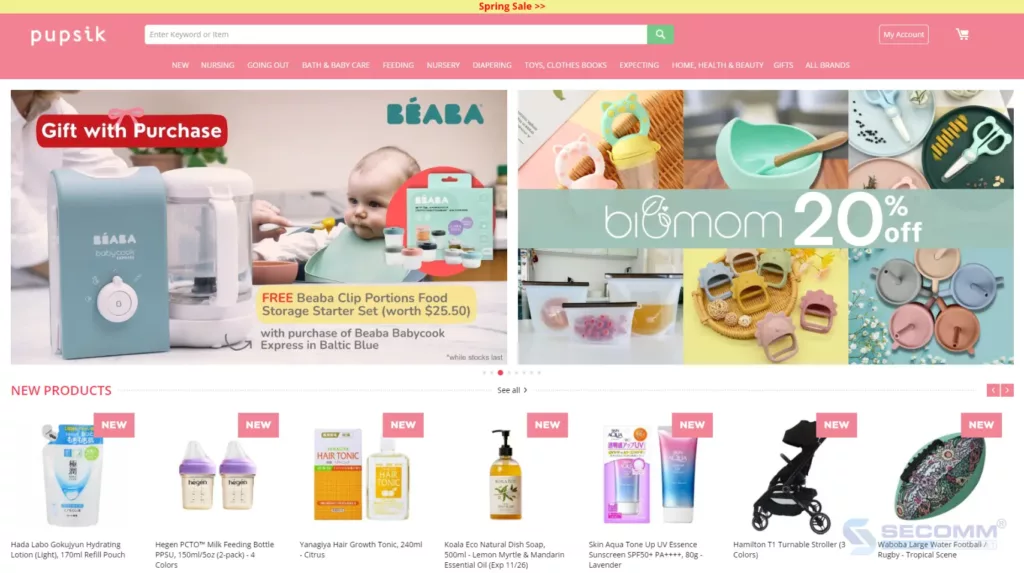
Pupsik is the go-to online shopping destination for parents in Singapore, where they can find everything they need for the care and nurturing of their children. With a humane mission and special attention to the needs of families, Pupsik is committed to providing a peaceful and convenient shopping experience.
Pupsik has built its Magento website to easily customize features and shopping experiences. From smart search features to product filtering and optimized checkout pages, every detail is focused on ensuring shopping becomes easy and quick.
In particular, Pupsik is famous for the diversity and quality of products for children and mothers. From clothing, toys to everyday essentials and healthcare products, they ensure that all family needs are comprehensively met.
Website: https://pupsik.sg/
Industry: Childcare
Traffic: 264,148/month
Ranking: #3,684 (Singapore) & #677,191 (Global)
7. Cellarbration
Cellarbration is the ideal destination in Singapore for wine and alcoholic beverage enthusiasts. This brand boasts an extensive collection of wines and alcoholic beverages from top brands worldwide.
Shopping on the eCommerce website is also efficiently optimized by Cellarbration through the power of the Magento platform. From search operations to product browsing and payment, everything is deeply customized to ensure customers have a more engaging shopping experience.
Not only prominent for the richness of products but also for professional and dedicated customer service. Cellarbration is committed to customer satisfaction by providing personalized support and diversifying payment options as well as delivery.
Website: https://cellarbration.com.sg/
Industry: Wine
Traffic: 125,878/month
Ranking#6,676 (Singapore) & #1,075,981 (Global)
8. Wine Collection
In Singapore, the Wine Collection brand is a favorite destination for wine enthusiasts who want to explore premium wines from the most famous wine regions in the world. Wine Collection also offers customers a rich and diverse collection of wines.
The Wine Collection’s Magento website is customized to optimize the experience, allowing customers to search for wines by origin, grape variety, explore special collections, and choose preferred payment and delivery methods.
Not only does it provide a modern and engaging online shopping space, but Wine Collection also serves as a source of wine knowledge. Customers can find articles and detailed guides on how to choose and enjoy wine to better understand the art and science behind the delicate flavors.
Website: https://wineconnection.com.sg/
Industry: Wine
Traffic: 82,788/month
Ranking: #12,447 (Singapore) & #1,701,444 (Global)
9. Far East Flora
Far East Flora is a brand specializing in providing plant products, fresh flowers, and decorations made from greenery. The Far East Flora Magento eCommerce website is built with a priority on customer experience through a user-friendly interface and deeply developed and customized features. Customers can search for plants by filtering by type, size, and make quick payments with just one page. Additionally, Far East Flora’s fast and reliable delivery service is highly rated by customers. The brand is committed to delivering quality products to customers’ hands safely and promptly, helping them decorate living spaces beautifully and meaningfully.
Website: https://fareastfloragarden.com/
Industry: Gardening
Traffic: 40,864/month
Ranking: #20,995 (Singapore) & #2,327,136
(Global)
10. First Few Years
First Few Years is not just a store but also a loyal companion for parents in the journey of caring for their children from the early years. With a dedicated spirit and profound understanding of children’s needs, First Few Years provides a meaningful and trustworthy shopping experience.
The Magento website of this brand is not only a place for shopping but also an important source of information and support for parents. From advising on safe toy selection and development to sharing experiences in childcare, all information is conveyed sincerely and meticulously.
Website: https://firstfewyears.com.sg/
Industry: Childcare
Traffic: 10,245/month
Ranking: #86,167 (Singapore) & #7,519,723 (Global)
The Bottom Line
Above are 10 leading Magento eCommerce websites in Singapore, each providing customers with a unique and memorable shopping experience. From product diversity to professional customer service, each website has prioritized the mission of serving and satisfying customers.
Need more advice to build your first Magento website? Contact SECOMM today!
 2
2

 322
322

 0
0

 1
1
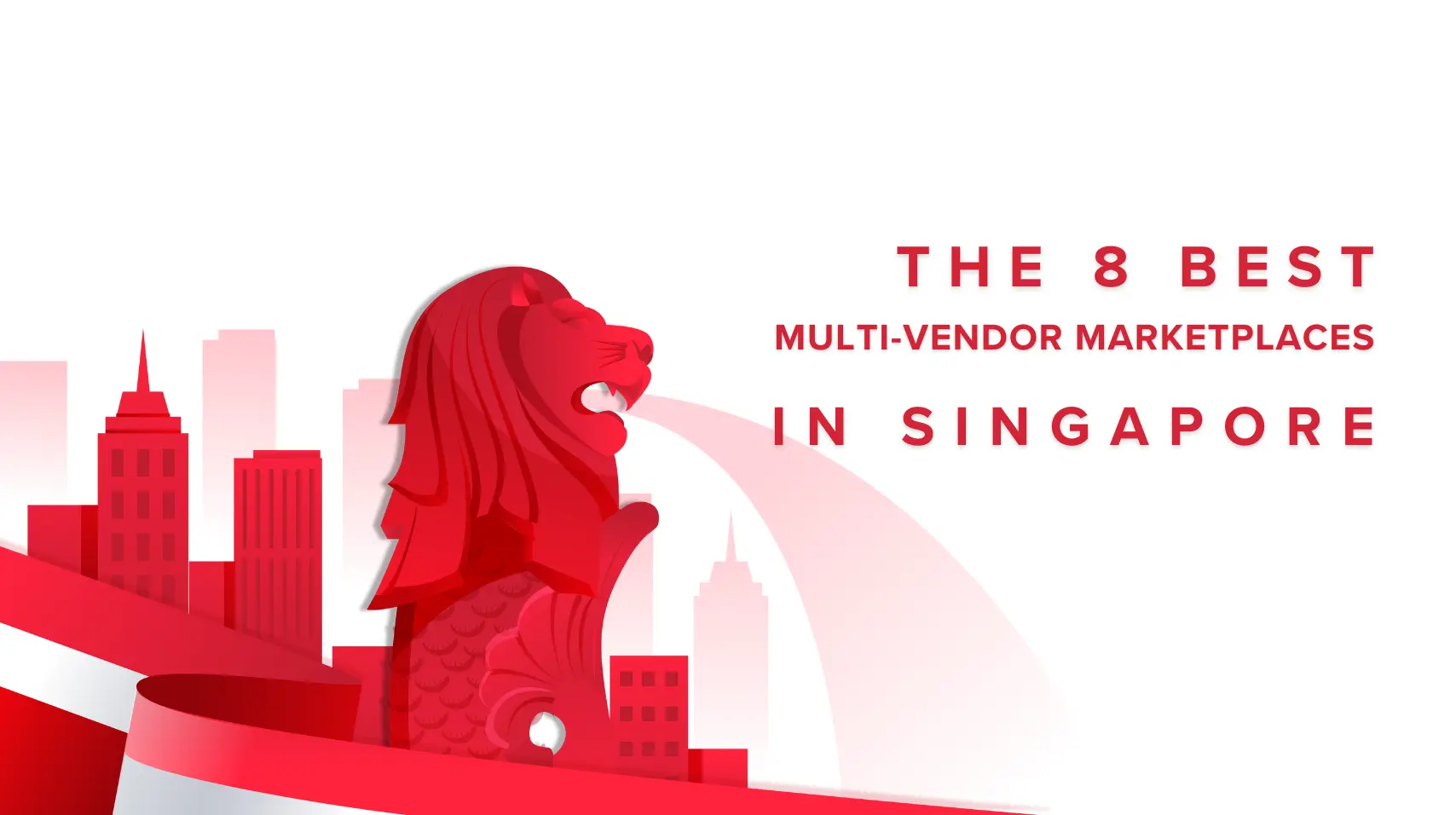
The 8 Best Multi-vendor Marketplaces in Singapore
The Singapore multi-vendor marketplace market is booming, with stiff competition from Western giants like Amazon and eBay, as well as trusted local brands such as Shopee and Lazada. Statista reports that in 2023, the industry’s revenue reached $4.45 billion and is projected to hit $5 billion in 2024 and $8.2 billion by 2029. In this context, identifying and understanding the leading online marketplaces in Lion City is crucial for maximizing potential and opportunities in this rapidly evolving market.
1. Shopee Singapore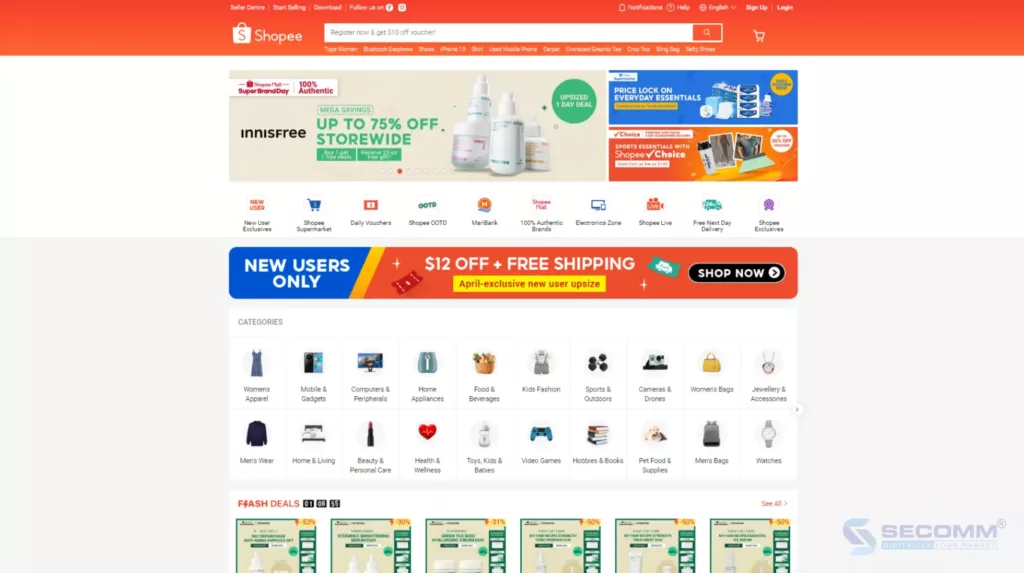
Shopee Singapore is one of the leading multi-vendor marketplaces not only in Singapore but also throughout the Southeast Asia region. The range of products available for purchase and sale on the Shopee platform is quite diverse, spanning from consumer goods to fashion, electronics, toys, and much more. Shopee Singapore is renowned not only for its convenience and flexibility in the online shopping process but also for its attractive promotional programs and fast delivery services. With its open and user-friendly business model, the eCommerce marketplace has become a popular destination for people looking for quality products at reasonable prices.
- Website: https://shopee.sg/
- Traffic: 45.69M/month
- Country rank: #11 (Singapore)
- Global rank: #3,332
- Industry rank: #1 (eCommerce & Shopping > Marketplace in Singapore)
2. Carousell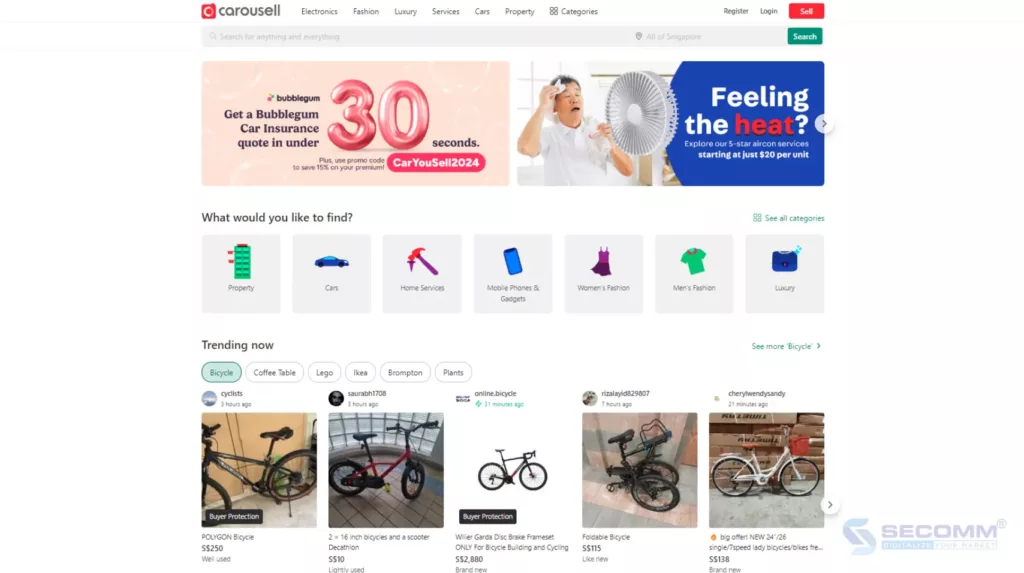
Carousell, a well-known online marketplace based in Singapore, offers a stylish and personalized online shopping experience. It specializes in enhancing the buying and selling process both on its website and mobile app. What makes Carousell stand out is its wide range of unique items available. Beyond just new products, Carousell also serves as an eCommerce marketplace for secondhand items, spanning from clothing and electronics to household goods. This creates an engaging shopping environment for those in search of one-of-a-kind items or looking to recycle goods.
- Website: https://www.carousell.sg/
- Traffic: 29.02M/month
- Country rank: #25 (Singapore)
- Global rank: #5,100
- Industry rank: #76 (eCommerce & Shopping > Marketplace in Singapore)
3. Amazon Singapore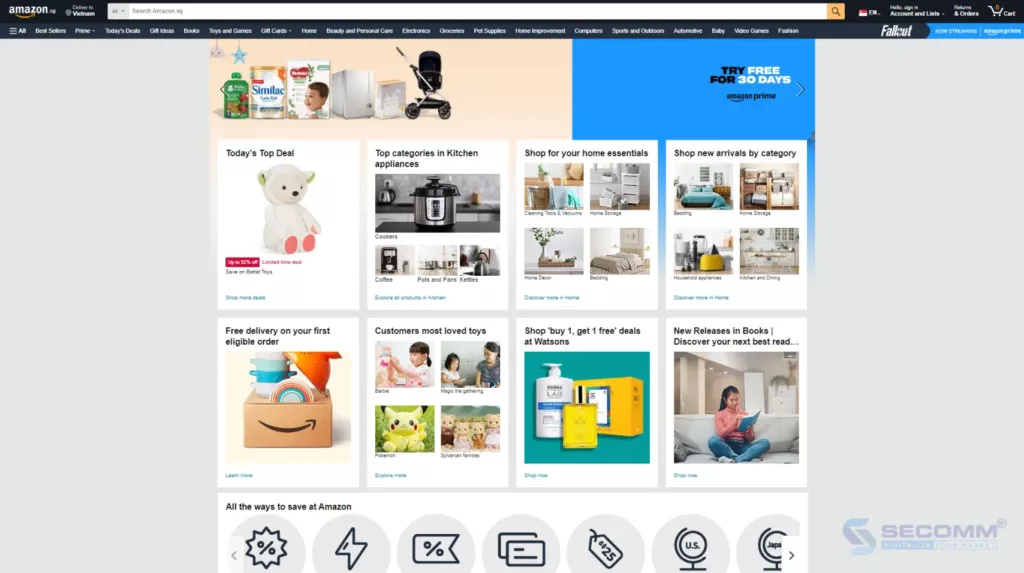
When expanding into the Singapore market, retail giant Amazon brought a top-notch and diverse online shopping experience to local customers. With an extensive array of products spanning from consumer electronics to books, fashion, household items, electronics, and cosmetics, Amazon serves as the preferred destination for customers seeking quality and variety.
A key strength of this multi-vendor marketplace lies in its reliable shipping infrastructure and customer service. With a widespread distribution network and efficient delivery services, Amazon ensures convenient and prompt product deliveries for buyers. Additionally, Amazon’s customer support service is highly regarded, as the company strives to address inquiries and issues from both sellers and buyers promptly and effectively.
- Website: https://www.amazon.sg/
- Traffic: 19.82M/month
- Country rank: #38 (Singapore)
- Global rank: #8,281
- Industry rank: #2 (eCommerce & Shopping > Marketplace in Singapore)
4. Lazada Singapore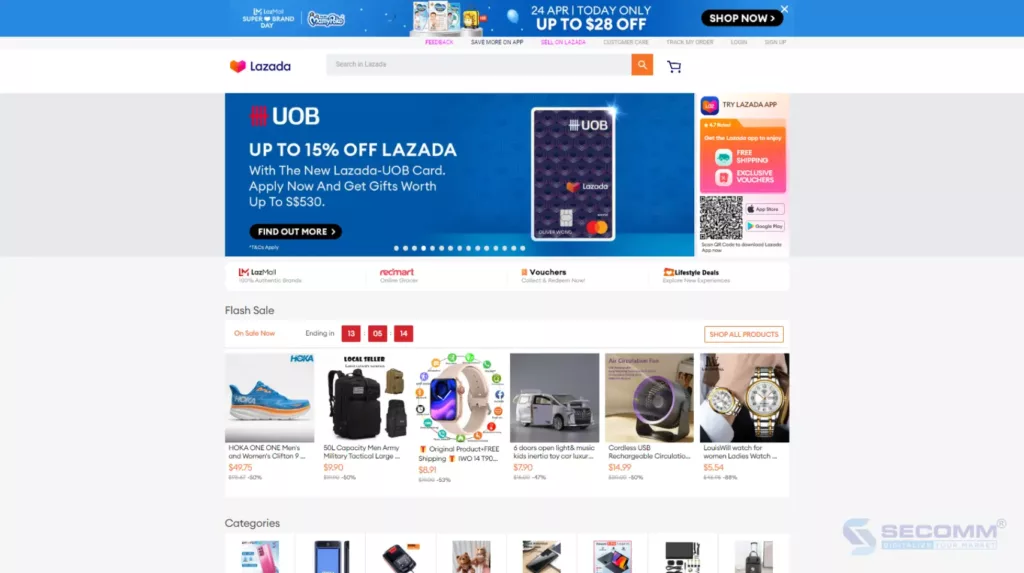
Lazada is one of the major players in the eCommerce world, winning over the trust of Singaporean consumers with its diverse range of services and products. Since being acquired by Alibaba, Lazada has experienced significant growth and strengthened its position in the Southeast Asian market. Today, Lazada serves not only as a platform for major brands but also as a gateway for small and medium-sized enterprises to enter the market effectively. Moreover, the online marketplace is renowned for its enticing promotional offers and swift delivery services. The incorporation of labels like “LazMall” and “LazGlobal” further simplifies the process for customers to discover and purchase quality products from brands worldwide.
- Website: https://www.lazada.sg/#?
- Traffic: 12.03M/month
- Country rank: #51 (Singapore)
- Global rank: #12,056
- Industry rank: #4 (eCommerce & Shopping > Marketplace in Singapore)
5. Qoo10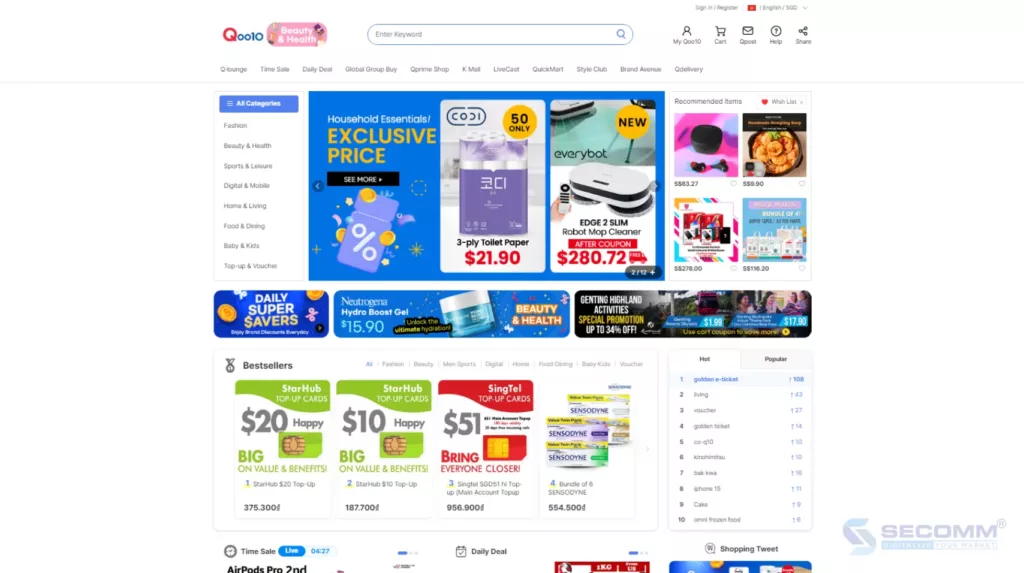
Qoo10, also known as Gmarket, stands as one of Singapore’s most popular and reliable eCommerce marketplaces. With its diverse range of online storefronts, Qoo10 offers users a stylish and varied online shopping experience.
A standout feature of Qoo10 is its emphasis on products from small and medium-sized retailers. Rather than focusing solely on major brands, Qoo10 provides a platform for small and medium enterprises to easily and effectively access the market. This creates a welcoming and diverse shopping environment where buyers can discover unique and high-quality products from smaller manufacturers and brands.
Moreover, the online marketplace is well-known for its appealing promotional programs and fast delivery services. The user rating and feedback system further bolsters trust and transparency in the online shopping process on this platform.
- Website: https://www.qoo10.sg/
- Traffic: 4.066M/month
- Country rank: #158 (Singapore)
- Global rank: #37,148
- Industry rank: #8 (eCommerce & Shopping > Marketplace in Singapore)
6. eBay Singapore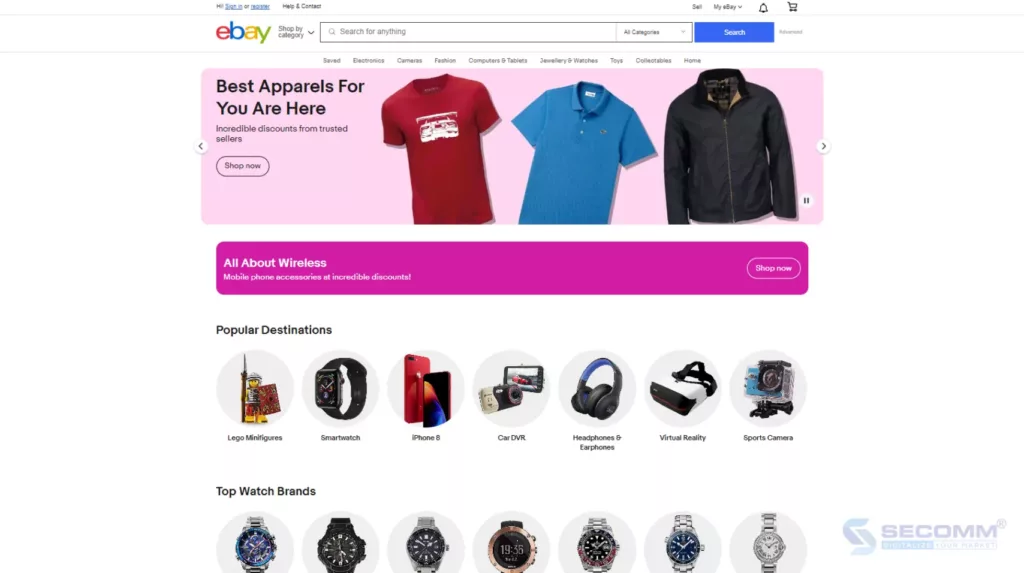
eBay is a well-established and trusted name in the global eCommerce landscape. It has won over Singaporean consumers with appealing and efficient online shopping experiences. eBay Singapore is renowned for its ability to connect buyers and sellers worldwide, creating a vast global online marketplace. With millions of items available for sale on the platform, ranging from brand-new to gently used products, customers can easily discover items that suit their needs and budgets.
Furthermore, the multi-vendor marketplace offers customers flexibility in payment and delivery options. Customers can opt for popular payment methods like PayPal or credit cards and also take advantage of international shipping services to have their purchases delivered directly to their doorstep.
- Website: https://www.ebay.com.sg/
- Traffic: 2.632M/month
- Country rank: #622 (Singapore)
- Global rank: #70,776
- Industry rank: #1,188 (eCommerce & Shopping > Marketplace in Singapore)
7. Zalora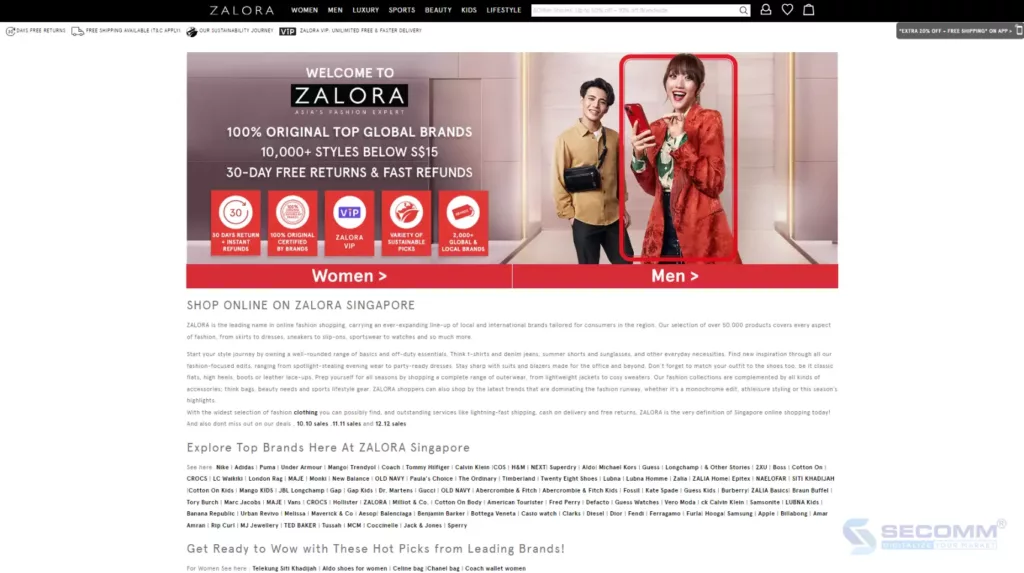
Zalora is a popular multi-vendor marketplace in Singapore, offering fashion and style products from both local and international brands. With its diverse array of items spanning from apparel, footwear, and accessories to jewelry and cosmetics, Zalora has become the go-to destination for fashion enthusiasts seeking to express their unique style. What sets Zalora apart is its dedicated focus on the fashion and style market, delivering users a flawless online shopping experience in this realm. Beyond just a platform for purchasing products from renowned brands, the eCommerce marketplace serves as a hub for individuals to explore and cultivate their style.
- Website: https://www.zalora.sg/
- Traffic: 2M/month
- Country rank: #271 (Singapore)
- Global rank: #59,178
- Industry rank: #1,448 (eCommerce & Shopping > Marketplace in Singapore)
8. EZbuy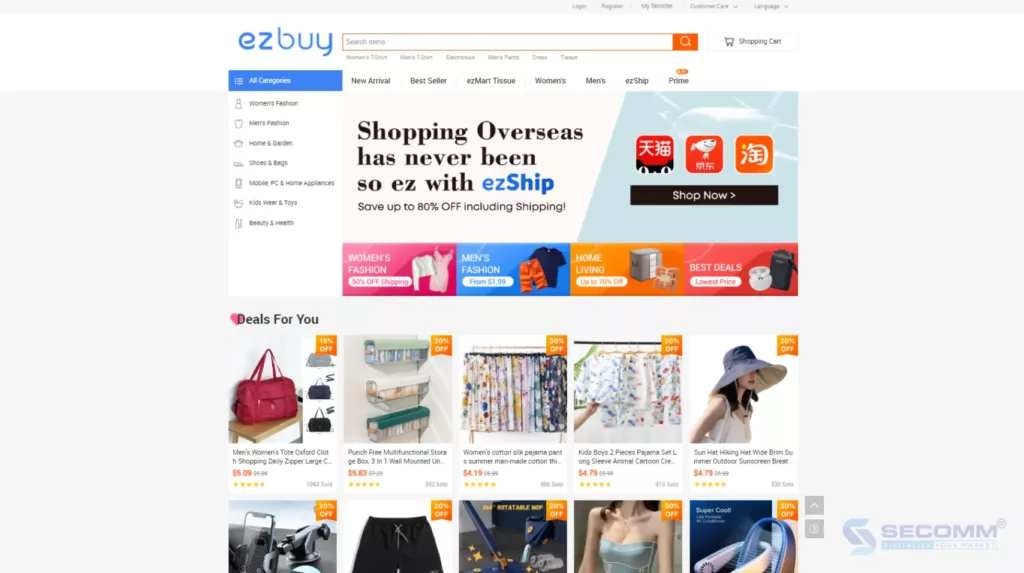
The online marketplace EZbuy is renowned for its convenient and cost-effective international shopping services. With EZbuy, customers can easily access and purchase hundreds of thousands of products from China, Korea, the US, and many other countries at reasonable prices with convenient shipping services.
Operating as an intermediary shopping model, the EZbuy eCommerce marketplace helps users circumvent complications related to import taxes, international shipping fees, and complex customs procedures. Instead of handling these procedures themselves, users can effortlessly shop for products from overseas through EZbuy and conveniently await delivery at home.
- Website: https://ezbuy.sg/
- Traffic: 885K/month
- Country rank: #758 (Singapore)
- Global rank: #173,853
- Industry rank: #2,968 (eCommerce & Shopping > Marketplace in Singapore)
The Bottom Line
In summary, the Singapore eCommerce market is thriving with a variety of top-tier multi-vendor marketplaces. Each platform offers unique features and the best services to meet the shopping needs of customers. The success of these giants serves as motivation for many businesses to join and lays the groundwork for further development of the eCommerce market in Singapore in the future.
Need more advice for multi-vendor marketplace development? Contact SECOMM today!
 16
16

 423
423

 0
0

 10
10

Top 10 Largest eCommerce Websites in Singapore 2024
Online shopping has become an indispensable trend in Singapore. Therefore, consumers in this city have set higher demands for their online shopping experience, driving businesses to strive for optimizing their eCommerce websites to provide a unique and best shopping experience for customers.
Below are 10 brands heavily investing in the online shopping experience in Singapore, as collected by SECOMM from BuiltWith, AfterShip, and Similarweb.
1. Charles & Keith
Charles & Keith, a leading fashion brand in Singapore, was founded in 1996 by two brothers Charles and Keith Wong. Focusing on footwear, handbags, and fashion accessories, Charles & Keith quickly gained attention in the market for its modern, youthful fashion style at affordable prices.
Charles & Keith has chosen Salesforce Commerce Cloud to build its website. Thus, Charles & Keith’s website features a range of functions to create the most convenient and comfortable online shopping experience for users. These include advanced search with filtering and sorting, detailed product views with high-quality images and customer ratings, secure shopping cart and payment, along with order tracking and purchase history. Additionally, customers can enjoy loyalty rewards, seek customer support, read fashion blogs, and connect on social media to stay updated on the latest trends. With this diversity and convenience, Charles & Keith’s eCommerce website in Singapore has provided an excellent online shopping experience for users.
- Website: https://www.charleskeith.com/
- Industry: Fashion
- Platform: Salesforce Commerce Cloud
- Traffic: 2.412M/month
- Ranking: #18,543 (Singapore) & #24,487 (Global)
2. FortyTwo
FortyTwo is a furniture and home accessories brand established in Singapore in 2007. FortyTwo offers a range of products from bedroom furniture, living room, kitchen to household items and interior decoration. The brand is known for providing quality products at competitive prices with fast delivery and attentive customer service. FortyTwo regularly updates and expands its product portfolio to meet diverse customer needs.
FortyTwo’s website is built on the Magento Open Source platform (Adobe Commerce free version). With this website, users can easily search and filter products, explore a variety of product categories from furniture to household items. Additionally, the website offers the ability to integrate attractive promotional campaigns and customer support, along with fast and secure delivery services.
- Website: https://www.fortytwo.sg/
- Industry: Furniture
- Platform: Magento Open Source
- Traffic: 625,855/month
- Ranking: #493 (Singapore) & #107,563 (Global)
3. COURTS
COURTS is a leading electronics retailer in Singapore, Malaysia, and Indonesia. With over 40 years of experience, COURTS offers customers a wide range of product choices, convenient services, and competitive prices.
COURTS uses Magento Open Source to build its eCommerce website. This website provides diverse and convenient online shopping experiences for users with functions such as product categories, specific product search, store information, and order tracking on the website. COURTS also provides support services and information about promotional programs and product news.
- Website: https://www.courts.com.sg/
- Industry: Electronics
- Platform: Magento Open Source
- Traffic: 510,240/month
- Ranking: #502 (Singapore) & #105,498 (Global)
4. Guardian Singapore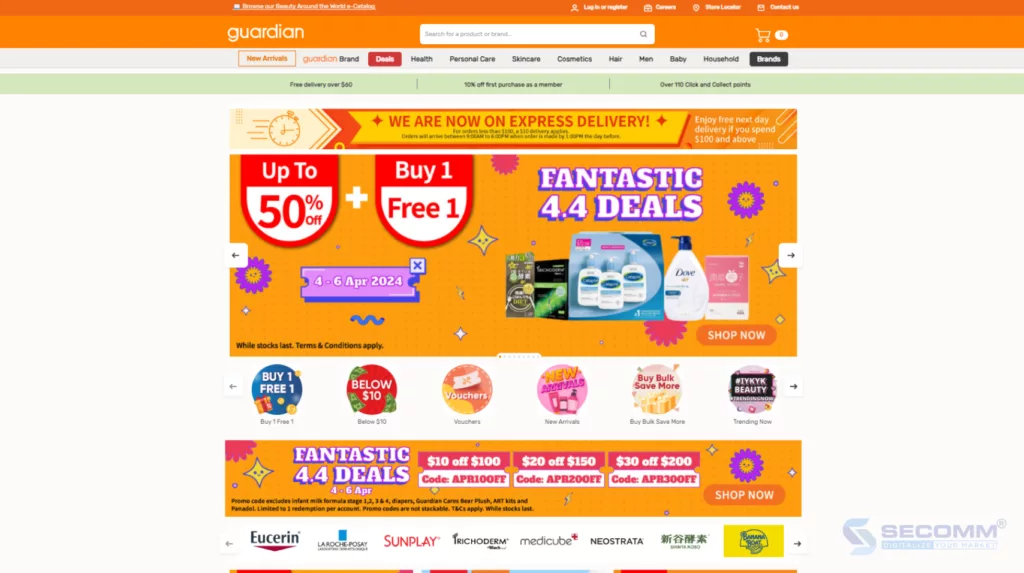
Guardian is a retail chain specializing in health care, cosmetics, and other consumer products. Guardian has a presence in many countries and regions around the world, including Singapore, with a range of products from famous and reliable brands.
Guardian’s website is built on the SAP Commerce Cloud platform, offering many useful features for users. Customers can easily search and purchase products, manage their shopping carts, and make convenient payments. At the same time, the website offers promotions and online support services to help customers have a comfortable and safe online shopping experience. Moreover, customers can also rate and provide feedback on products, providing useful information for other users.
- Website: https://www.guardian.com.sg/
- Industry: Cosmetics
- Platform: SAP Commerce Cloud
- Traffic: 429,041/month
- Ranking: #462 (Singapore) & #110,350 (Global)
5. Sephora Singapore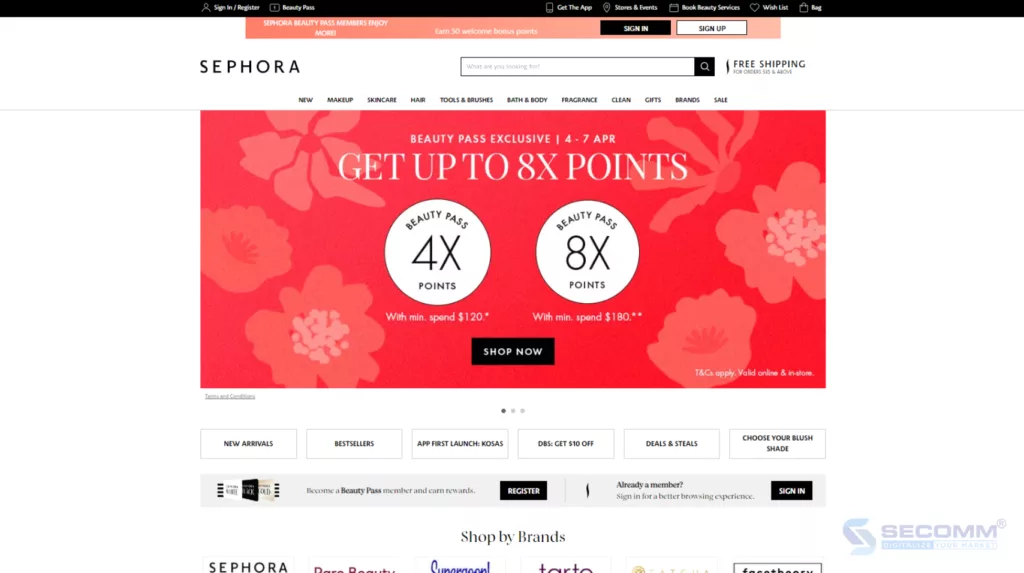
Similar to Guardian, Sephora is a global retail chain of cosmetics and beauty products, known for offering a range of cosmetics, skincare, and beauty products from leading brands worldwide. Currently, Sephora has a presence in the Singapore market with physical stores in major shopping centers and an eCommerce system, including a website and app for customers. Sephora is favored for its product diversity, customer care services, and innovation in the online cosmetics shopping experience.
Sephora’s eCommerce system in Singapore is built on the Vue.js and Nuxt.js programming languages. With this system, Sephora customers can quickly search and explore products through smart search and various filters. The online shopping experience is optimized with detailed product information, sharp images, and customer reviews.
Sephora’s app is also highly rated, making shopping easier for customers with features like “Virtual Artist” and receiving notifications about promotions. In general, Sephora offers a range of features and services to meet customers’ cosmetics shopping needs, creating a professional and convenient online shopping experience.
- Website: https://www.sephora.sg/
- Industry: Cosmetics
- Programming Languages: Vue.js, Nuxt.js
- Traffic: 396,282/month
- Ranking: #714 (Singapore) & #136,020 (Global)
6. Pet Lovers Centre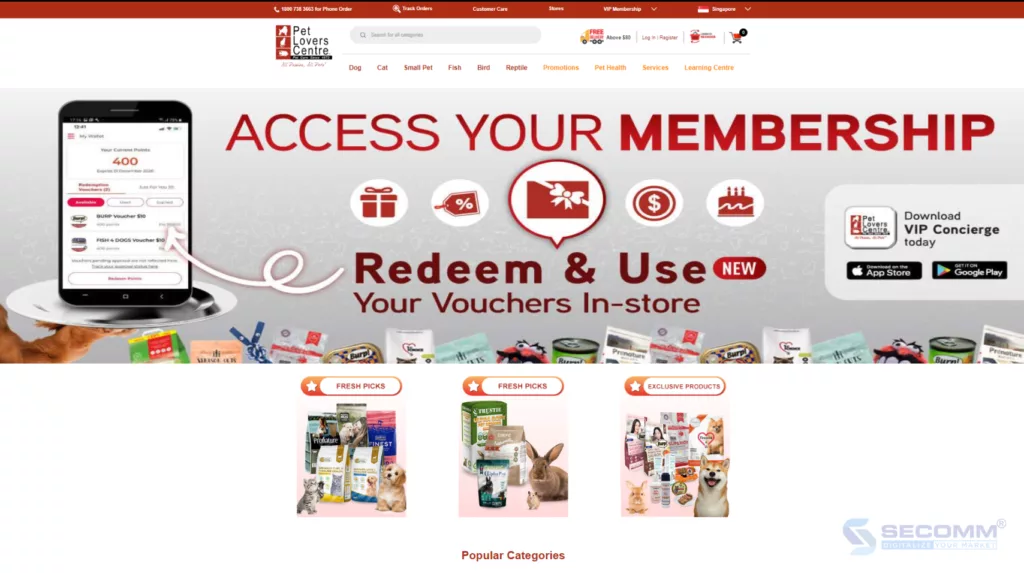
Pet Lovers Centre is a leading pet products and services retailer in Asia. Established in 1973 in Singapore, Pet Lovers Centre now has over 160 stores in 5 countries: Singapore, Malaysia, Thailand, the Philippines, and Vietnam. Pet Lovers Centre is committed to providing quality products and services from reputable brands at competitive prices.
The Pet Lovers Centre website is built using PHP programming language and has outstanding features to provide users with a convenient online shopping experience. Users can search for products based on various criteria and use filters to select suitable products. The multi-layered product categories are classified by pet type, ensuring diversity and richness. The VIP Member program brings benefits to customer loyalty strategies. Integrating customer reviews on Google Maps helps users evaluate the quality of products and services provided by Pet Lovers Centre. Additionally, the website builds a quick shopping function to save time, customer management feature, and reorder support to efficiently manage customer information and orders.
- Website: https://www.petloverscentre.com/
- Industry: Pets
- Programming Language: PHP
- Traffic: 221,220/month
- Ranking: #2,256 (Singapore) & #310,418 (Global)
7. HipVan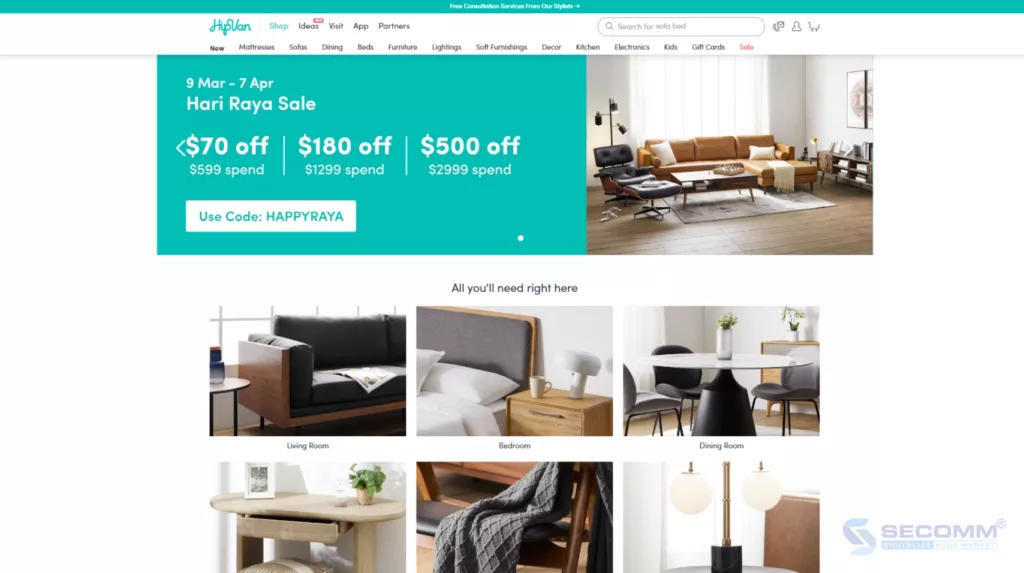
HipVan is an online retail website specializing in furniture and home decor, headquartered in Singapore. The brand was founded in 2013 with the aim of providing customers with high-quality furniture products at affordable prices, along with a convenient shopping experience and excellent customer service.
HipVan’s website is built using the Ruby on Rails and React framework, with Ruby being the primary programming language. Its notable features include building a community for sharing interior design ideas, image-based product search, and allowing customers to upload images of desired products. Particularly, the augmented reality (AR) feature enables customers to view products in their real-life space before making a purchase. Additionally, HipVan offers free interior planning services to help customers conveniently plan and design their living space.
- Website: https://www.hipvan.com/
- Industry: Furniture
- Frameworks: Ruby on Rails, React
- Traffic: 215,919/month
- Ranking: #1,034 (Singapore) & #225,419 (Global)
8. The Hour Glass
The Hour Glass is a premium watch retailer in Singapore founded in 1974. Currently, The Hour Glass has over 50 stores worldwide and is an authorized distributor for many leading watch brands such as Rolex, Patek Philippe, Audemars Piguet, Omega, Cartier, and more.
The Hour Glass’s online store is built on the WooCommerce platform and CMS WordPress, providing a convenient platform for customers to explore and purchase watches from renowned brands like Rolex, Patek Philippe, Audemars Piguet, and other luxury brands. In addition to product offerings, the website also provides detailed information about the services offered by The Hour Glass, including repairs, maintenance, and polishing of watches, to help customers maintain and preserve their products effectively. Furthermore, the website continuously updates the latest news in the watch industry along with special events organized by The Hour Glass, creating a comprehensive and immersive experience for users.
- Website: https://www.thehourglass.com/
- Industry: Watches
- Platform: WooCommerce
- Traffic: 206,204/month
- Ranking: #3,305 (Singapore) & #201,956 (Global)
9. Megafurniture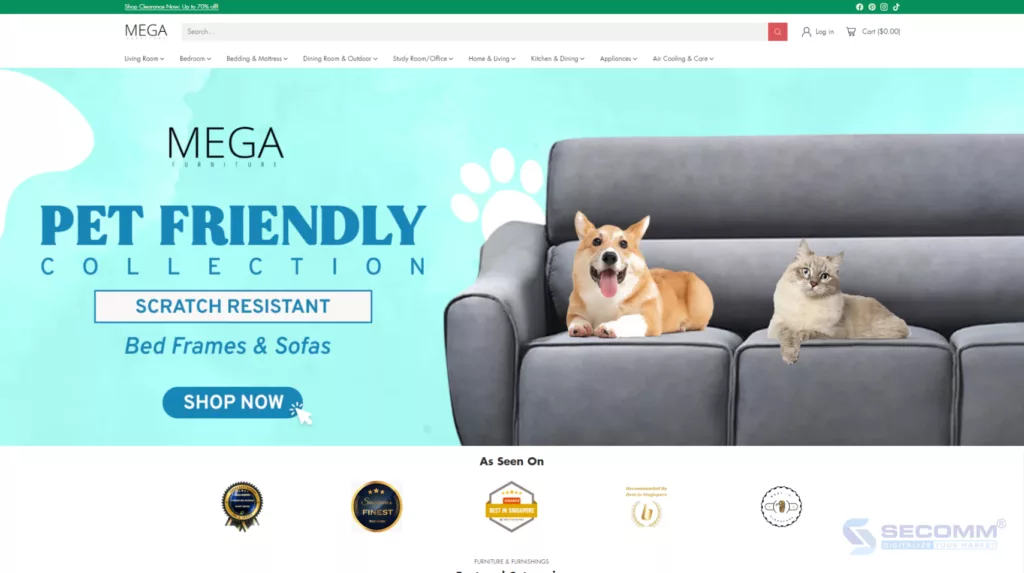
Megafurniture is a furniture retail company in Singapore, specializing in providing a range of furniture products for living rooms, bedrooms, dining rooms, and various other spaces in homes. Megafurniture is known for offering affordable and high-quality products, attracting the interest of many consumers. Additionally, the furniture brand is also renowned for its early investment in the online store, allowing customers to conveniently shop for furniture online.
Megafurniture’s website is built on the leading Shopify Plus platform, with basic and advanced features optimized for the furniture industry. The purchasing process is designed to be simple and straightforward, providing a convenient online shopping experience for customers. Secure online payment support through various methods increases flexibility for consumers. Megafurniture also offers multiple delivery and installation options to meet customer needs. Moreover, features like quick product view and product comparison assist users in making smart and efficient purchasing decisions. This, combined with fast checkout features, significantly enhances the online shopping experience.
- Website: https://megafurniture.sg/
- Industry: Furniture
- Platform: Shopify Plus
- Traffic: 145,329/month
- Ranking: #3,630 (Singapore) & #382,030 (Global)
10. Skin Inc
Skin Inc is a skincare brand specializing in manufacturing and distributing high-quality skincare products. The company focuses on providing skincare solutions, including brightening, moisturizing, anti-aging, and treating various skin concerns.
Skin Inc transitioned from the Magento platform to Shopify Plus in 2019, aiming to enhance the customer experience by deploying multiple website versions for different markets and customer segments. Using the LaunchPad feature, Skin Inc employees can create sales events without developer assistance. Additionally, Shopify Plus seamlessly integrates with marketing tools and loyalty programs, enabling personalized communication and data-driven marketing strategies.
- Website: https://www.iloveskininc.com.sg/
- Industry: Cosmetics
- Platform: Shopify Plus
- Traffic: 14,243/month
- Ranking: #11,439 (Singapore) & #1,609,988 (Global)
Conclusion
The above is a list of the top 10 eCommerce websites in Singapore. By implementing leading platforms such as Magento Open Source, Shopify Plus, and various others, these brands provide optimized online shopping experiences, attracting the interest of customers both domestically and internationally.
During its development process, SECOMM has collaborated with numerous clients from Singapore to create notable eCommerce websites, with the most prominent being the project to develop an online liquor supply system at Changi Airport.
 2
2

 418
418

 0
0

 1
1
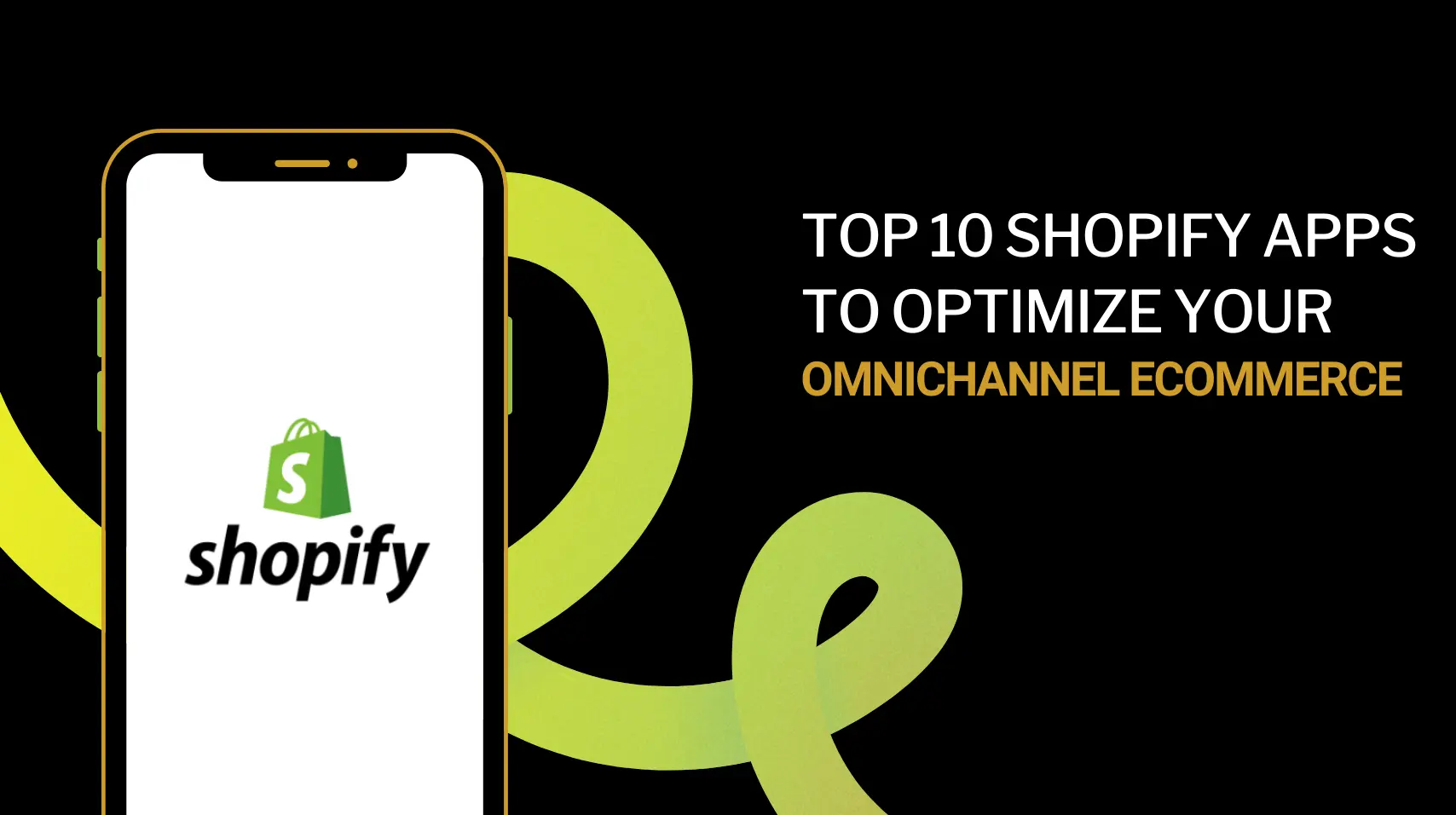
Top 10 Shopify Apps to Optimize Your Omnichannel eCommerce
Shopify apps are recognized not just for their range of exceptional tools and features but also as robust and adaptable catalysts for business growth within the Shopify ecosystem. Beyond the code and user-friendly interfaces, Shopify apps are reshaping how businesses engage with customers both online and in-store.
But what happens when these Shopify apps are integrated into an Omnichannel system? The answer lies in the seamless combination of technology and business strategy, creating a unified and appealing shopping experience across every channel.
In this article, let’s delve into 10 top Shopify apps that you need to know to elevate your Omnichannel eCommerce strategy to new heights and deliver true value to your customers.
Shopify POS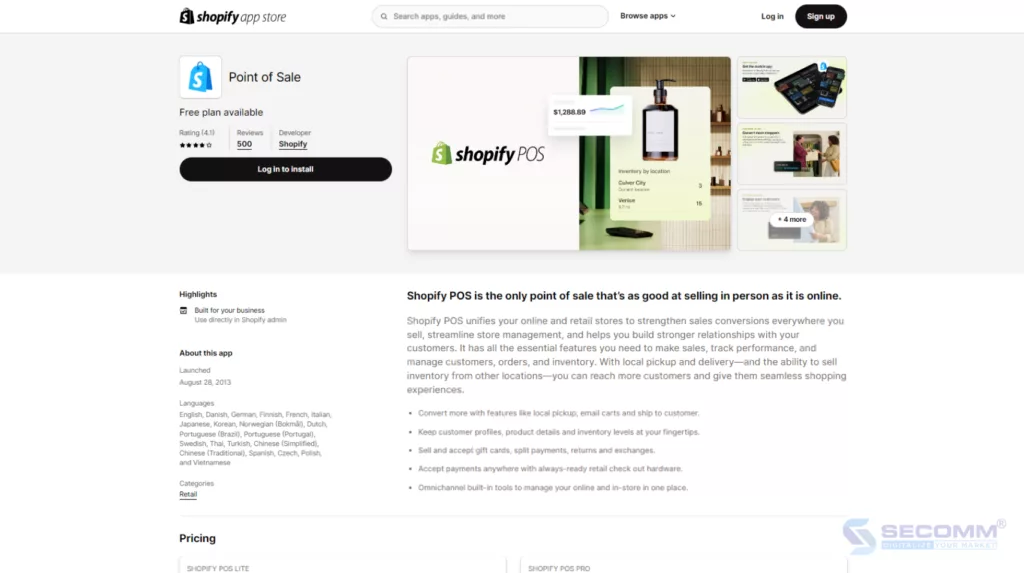
POS (Point of Sales) is known as Shopify’s most comprehensive solution for supporting online, offline and omnichannel sales activities. This Shopify app comes in two versions: Lite and Pro. Both enable merchants to accept payments, manage customer profiles, handle inventory, and track orders from all channels on a unified platform. Integrating Shopify POS helps deploy Omnichannel eCommerce more efficiently, delivering a seamless customer experience from online to offline with various shopping options such as:
- Buy online, Pick up in store
- Buy online, return and exchange in store
- Buy in-store, ship to customer
- Browse in-store, buy online
Rating: 4.1/5
Key features:
- Offers diverse shopping methods to boost conversions
- Manages customer profiles, product details, orders, and inventory rigorously
- Seamlessly connects and syncs data across sales channels
- Facilitates the sale and redemption of digital and physical gift cards both in-store and online
- Allows accepting multiple payment methods in a single transaction
Price:
- Shopify POS Lite: Included in all Shopify plans. Limited staff access, basic customer profiles, and allows returns at the original purchase location
- Shopify POS Pro: $89/month/location. Free for Shopify Plus merchants. Unlimited staff access, enables omnichannel sales, advanced customer profiles, professional sales reporting, and allows returns at any purchase location.
Smile: Loyalty & Rewards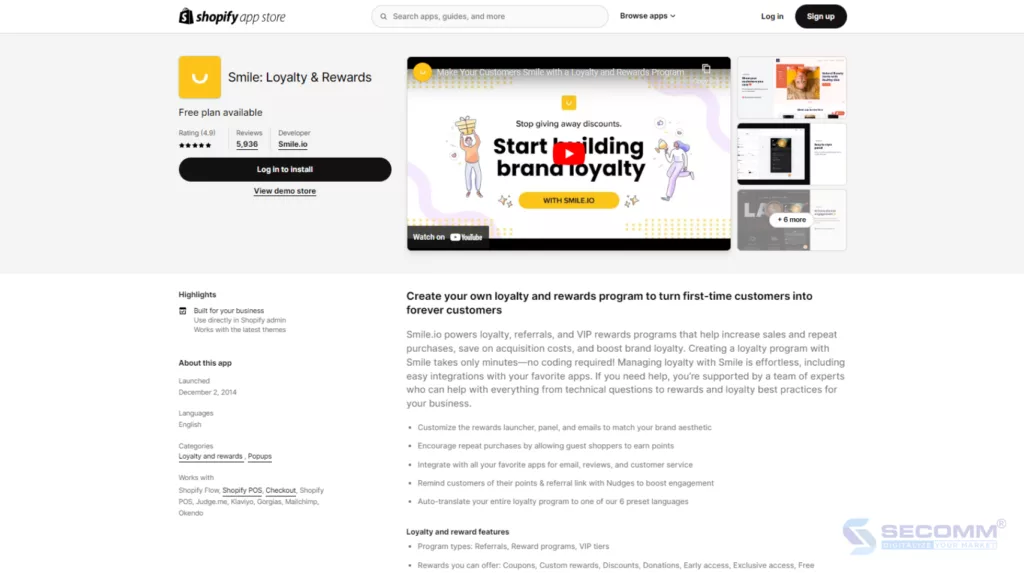
Smile is an easy-to-use platform designed to create promotional campaigns and customer loyalty programs, aiming to boost sales and customer retention. With Smile, you can establish point systems, discount vouchers and special offers to encourage repeat purchases and enhance customer interactions across various channels.
As one of the valuable Shopify apps for deploying Omnichannel eCommerce, Smile facilitates seamless integration with other marketing and sales campaigns such as email, subscriptions, and POS. This ensures a more intuitive, diverse, and engaging experience for customers.
Rating: 4.9/5
Key features:
- Create and customize loyalty programs with flexible point accrual and redemption rules
- Seamlessly integrate with popular apps like Klaviyo, Gorgias, Shopify POS, and Judge.me
- Automatically translate loyalty programs into six available languages including English, French, Portuguese, German, Spanish, and Chinese
- Allow non-members to earn and redeem points
Price:
- Free: Installation at no cost, with up to 200 orders per month
- Starter: $49/month, with up to 500 orders per month
- Growth: $199/month, with up to 2,500 orders per month
- Plus: $999/month, with up to 7,500 orders per month
Avada Email Marketing & SMS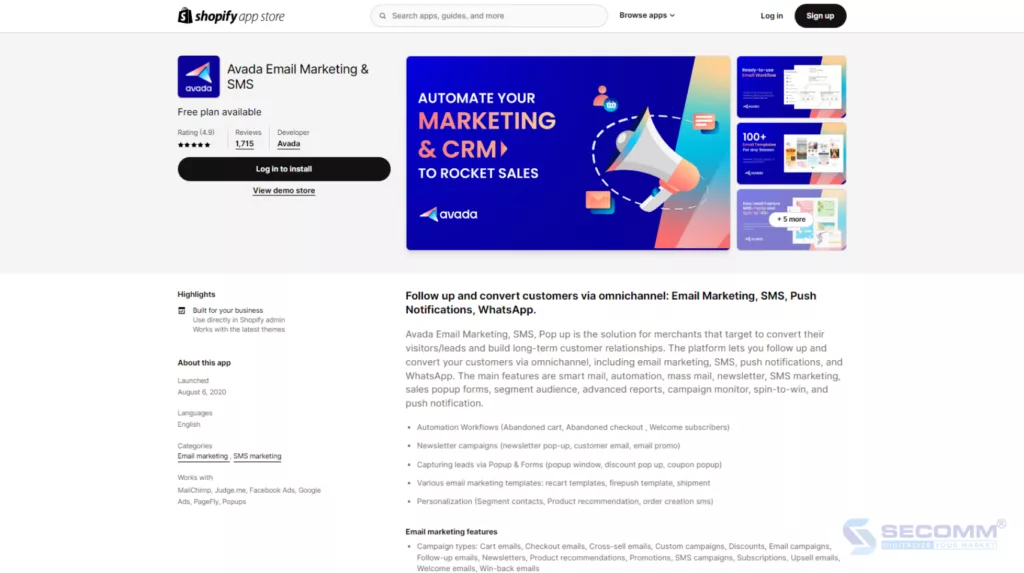
Avada is one of Shopify Omnichannel apps that allows to create and automate email marketing and SMS strategies. Regarded as an efficient solution, it enables brands to engage, follow up, convert, and foster long-term customer relationships through various channels such as email, SMS, pop-ups, push notifications, and WhatsApp. This facilitates seamless Omnichannel Marketing optimization across online and offline platforms.
Rating: 4.9/5
Key features:
- Automates Omnichannel Marketing workflows
- Offers a diverse range of email marketing templates
- Allows creating and sending of various email types within newsletter campaigns
- Captures potential customers through forms and pop-ups
- Personalized email and SMS messages
- Provides a simple and user-friendly editor
Price:
- Free: Includes up to 12,000 emails, basic automation, and standard email templates
- Pro: $16/month, includes up to 12,000 emails/month, unlimited automation, access to all email templates, and supports SMS and WhatsApp
- Advanced: $47/month, includes unlimited emails, all Pro plan features, integration with Google and Facebook Ads, and admin account management.
Zendesk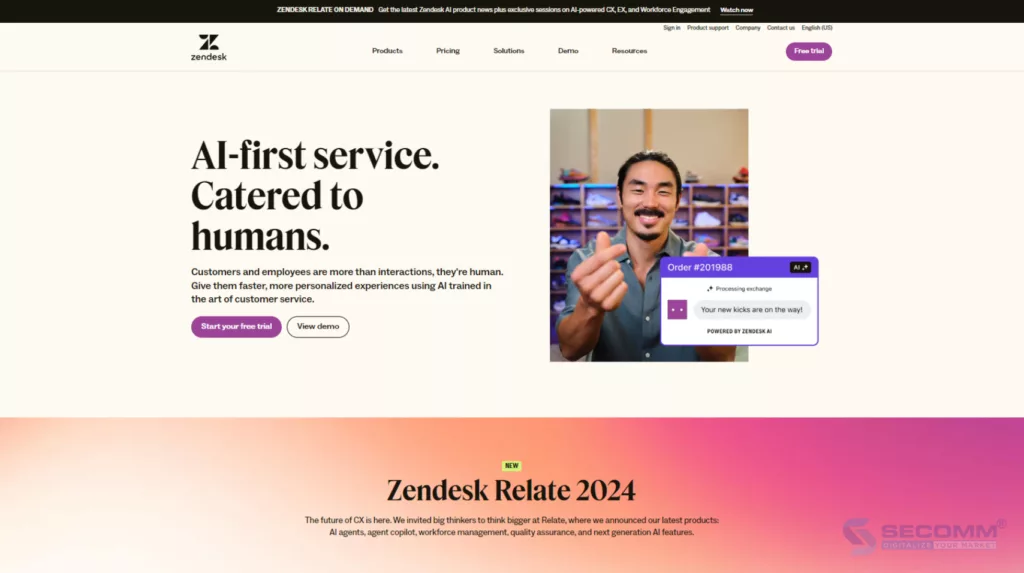
Deploying Omnichannel eCommerce or any type of online business requires meticulous customer care services. Zendesk is the perfect solution to streamline this process.
This Shopify Omnichannel app enables you to engage with customers via email, hotline, live chat, social media, and various other channels, all managed through a single, simple and intuitive dashboard. Integrating the Zendesk app into the Shopify system can enhance customer relationships and efficiently resolve customer issues.
Rating: 2.9/5
Key features:
- Allows access to customer data for quick and personalized support
- Processes refunds, and cancels orders directly from the Zendesk app sidebar
- Embeds live chat into any sales channel with just one click
Price:
- Suite Team: $55/month
- Suite Growth: $89/month
- Suite Professional: $115/month
- Suite Enterprise: $150/month
Stocky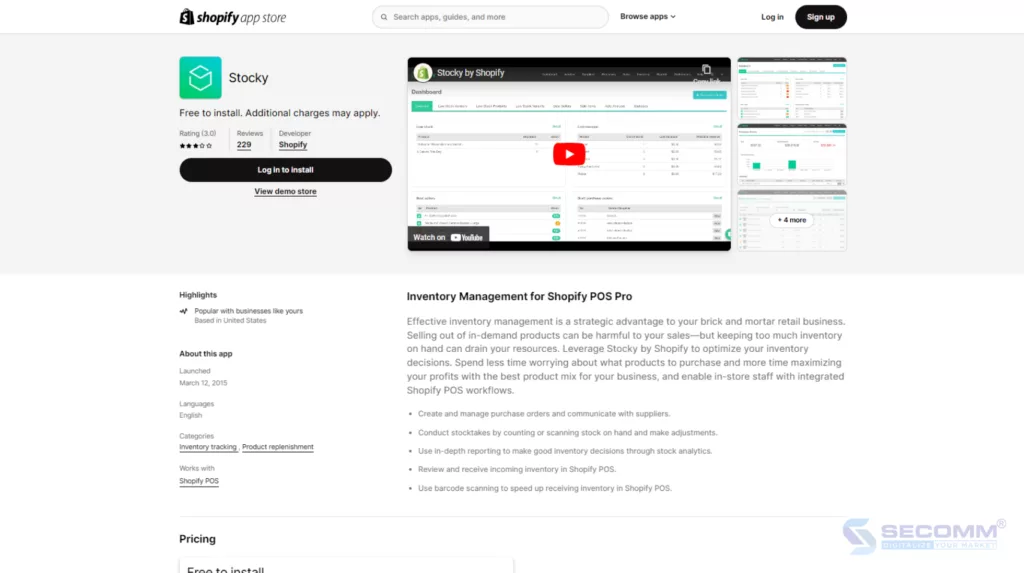
This inventory management app is specifically designed for Shopify POS Pro, offering the most advanced and comprehensive inventory solution to date. It’s also a valuable Shopify app to integrate for effective Omnichannel eCommerce deployment. Stocky allows the synchronization of order and inventory data between online and offline retail stores. This helps optimize inventory management, streamline business processes, and provide a seamless shopping experience for customers.
Rating: 2.9/5
Key Features:
- Pre-built integration with Shopify POS Pro
- Allows review and receipt of inventory data input from POS
- Utilizes barcode scanning functionality to expedite receiving inventory data from POS
- Enables creation and management of orders and contacts with suppliers
- Facilitates inventory counting by either manually counting or scanning items in the warehouse and making necessary adjustments
- Provides in-depth reports to make accurate inventory decisions through inventory data analysis
Price: Free to use
Deputy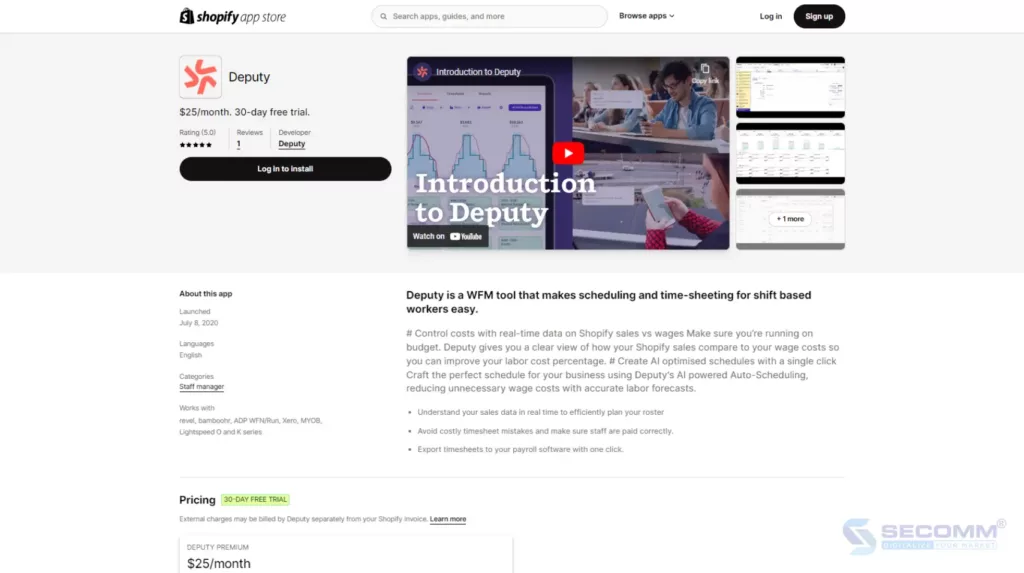
Managing personnel during Omnichannel eCommerce deployment is a challenge. Deputy is here to help overcome that challenge. With Deputy, you can optimize employee management processes and your schedules.
This Shopify app enables managers to monitor employee schedules, efficiently manage shifts, and assign tasks effectively. Additionally, Deputy leverages real-time data from Shopify sales reports, allowing managers to optimize employee schedules to minimize costs. Deputy also offers quick and accurate digital timesheets for payroll calculations.
Rating: 5/5
Key Features:
- Provides easily understandable sales data to plan and schedule employees more effectively
- Avoids costly timekeeping errors and ensures accurate payroll for employees
- Export timesheets to the business’s payroll software with just one click.
Price: Free 30-day trial. $25/month.
Endear CRM and Clienteling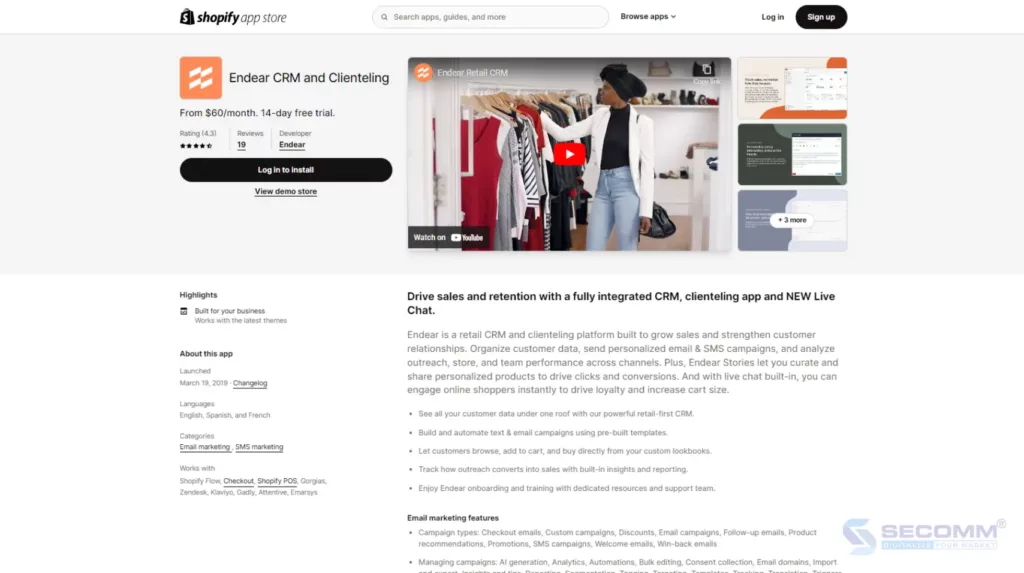
Endear is a powerful CRM and customer care app designed to help retailers increase sales and strengthen customer relationships. This Shopify app allows businesses to organize customer data, send personalized emails and SMS messages, and analyze employee outreach capabilities and sales performance.
Rating: 4.3/5
Key Features:
- Enables access to and management of all customer data on a single platform
- Builds and automates SMS and email campaigns using pre-designed templates
- Provides in-depth sales reporting and built-in integration
Price: Free 14-day trial
- Starter: $60/month. Up to 1,000 emails + 250 SMS
- Growth: $160/month. Up to 9,000 emails + 500 SMS
- Pro: $300/month. Up to 15,000 emails + 1,000 SMS
Omisell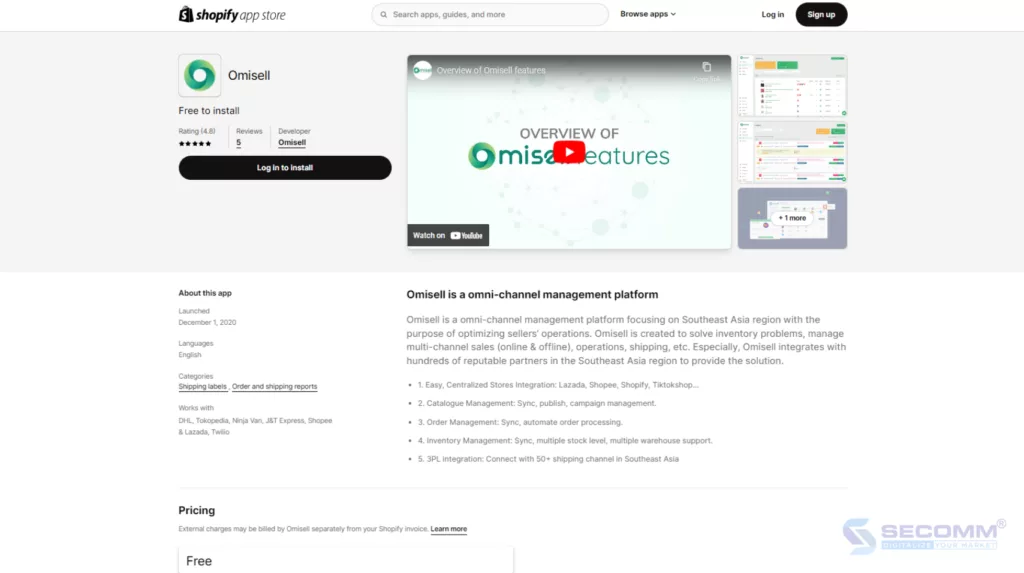
Omisell is a leading multi-channel management application, that allows one to manage orders, inventory, and deliveries across multiple sales channels from a single interface. This Shopify app helps optimize management processes and ensures synchronization between various sales channels.
Rating: 4.6/5
Key Features:
- Easy integration and management of multiple sales channels: Lazada, Shopee, Shopify, Tiktokshop.
- Seamless management of categories and synchronization across channels
- Order management, automatic synchronization, and processing
- Inventory management and synchronization
- Integration with 50+ shipping service providers across Southeast Asia
Price: Free to use
Progus Store Locator Map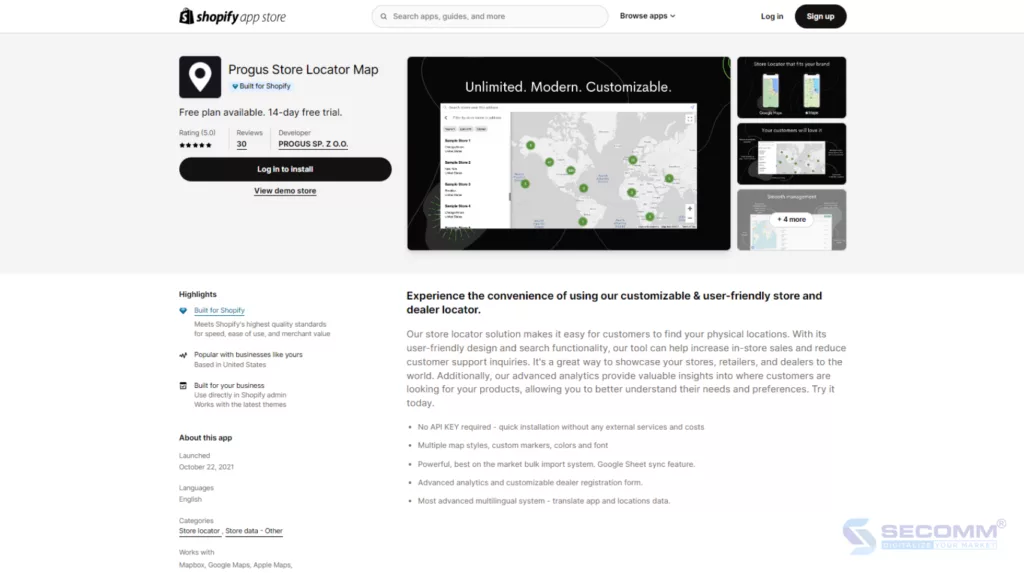
Progus is one of the useful Shopify apps that allows users to create a map displaying retail stores on the eCommerce website. This will help customers easily search for and locate the nearest store to them. This Shopify app creates a convenient and seamless shopping experience for customers from online to offline, while helping increase conversion rates.
Rating: 5/5
Key Features:
- Multiple map styles, customizable markers, colors, and fonts
- Provides advanced and customizable reporting
- Multilingual system, providing language translation apps
- Quick and easy setup, no API connection required
Price: Free 14-day trial
- Free: 1 store location. Multilingual, various map styles, and markers
- Basic: $9.99/month. Up to 100 store locations. Multilingual, various map styles, and markers
- Standard: $19.99/month. Up to 500 store locations. Multilingual, various map styles, and markers
- Unlimited: $29.99/month. Unlimited store locations. Multilingual, various map styles, and markers.
JivoChat: Live Chat & WhatsApp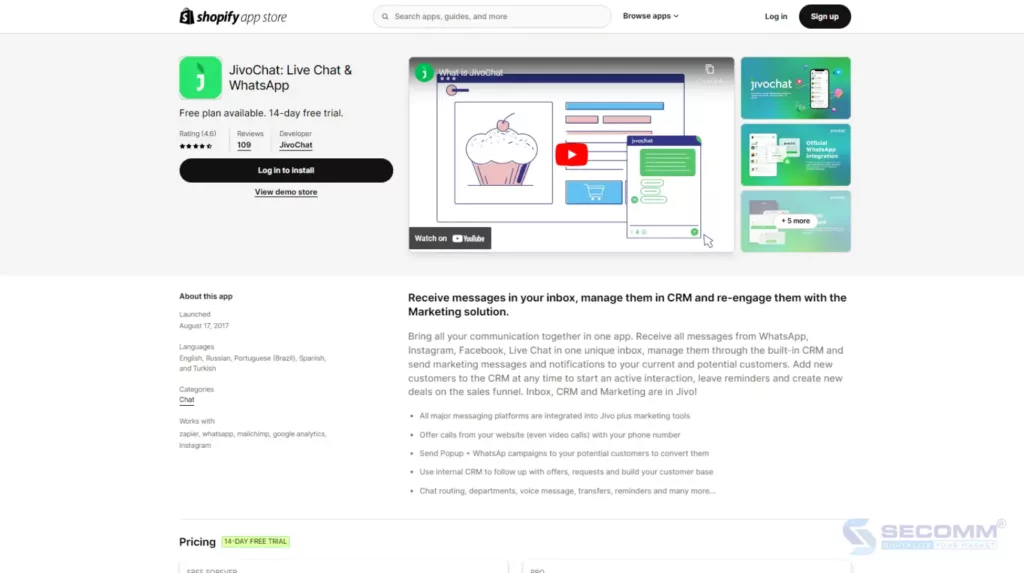
JivoChat is an app that enables users to engage in messaging exchanges to directly support customers from the eCommerce website. JivoChat can integrate and receive messages from popular platforms such as Facebook, Instagram, WhatsApp, and LiveChat. All messages are efficiently managed through an internal CRM system, allowing appropriate notifications or marketing messages to be sent to current and potential customers. This Shopify app not only provides an engaging multi-channel chat experience for customers but also strengthens the relationship between them and the business, significantly increasing conversion rates.
Rating: 4.7
Key Features:
- Integration with the most popular messaging platforms
- Allows making calls from the eCommerce website (even video calls) using phone numbers
- Deploy pop-up message campaigns + WhatsApp to convert potential customers
- Utilizes an internal CRM system to track offers, support requests, and build customer profiles
Price:
- Free Forever: Free for up to 5 users, unlimited live chat and website support, supports translation into 20 languages
- Pro: $29/month. Free 14-day trial, provides detailed information about website visitors and real-time tracking of their behavior on the website.
The Bottom Line
In recent years, deploying Omnichannel eCommerce has become not just an option but a necessity for a brand to survive and thrive. With support from leading Shopify apps, brands can build a robust and flexible multi-channel sales system, providing a memorable shopping experience for their customers.
From Shopify POS to Smile, Zendesk, and Stocky, each application offers unique solutions to optimize Omnichannel eCommerce strategies. From inventory management to creating promotional strategies and direct customer interactions, each tool plays a crucial role in enhancing the shopping experience and strengthening customer relationships.
Need advice on choosing the most suitable Shopify app? Contact SECOMM or call the hotline (028 7108 9908) today!
 2
2

 328
328

 0
0

 1
1
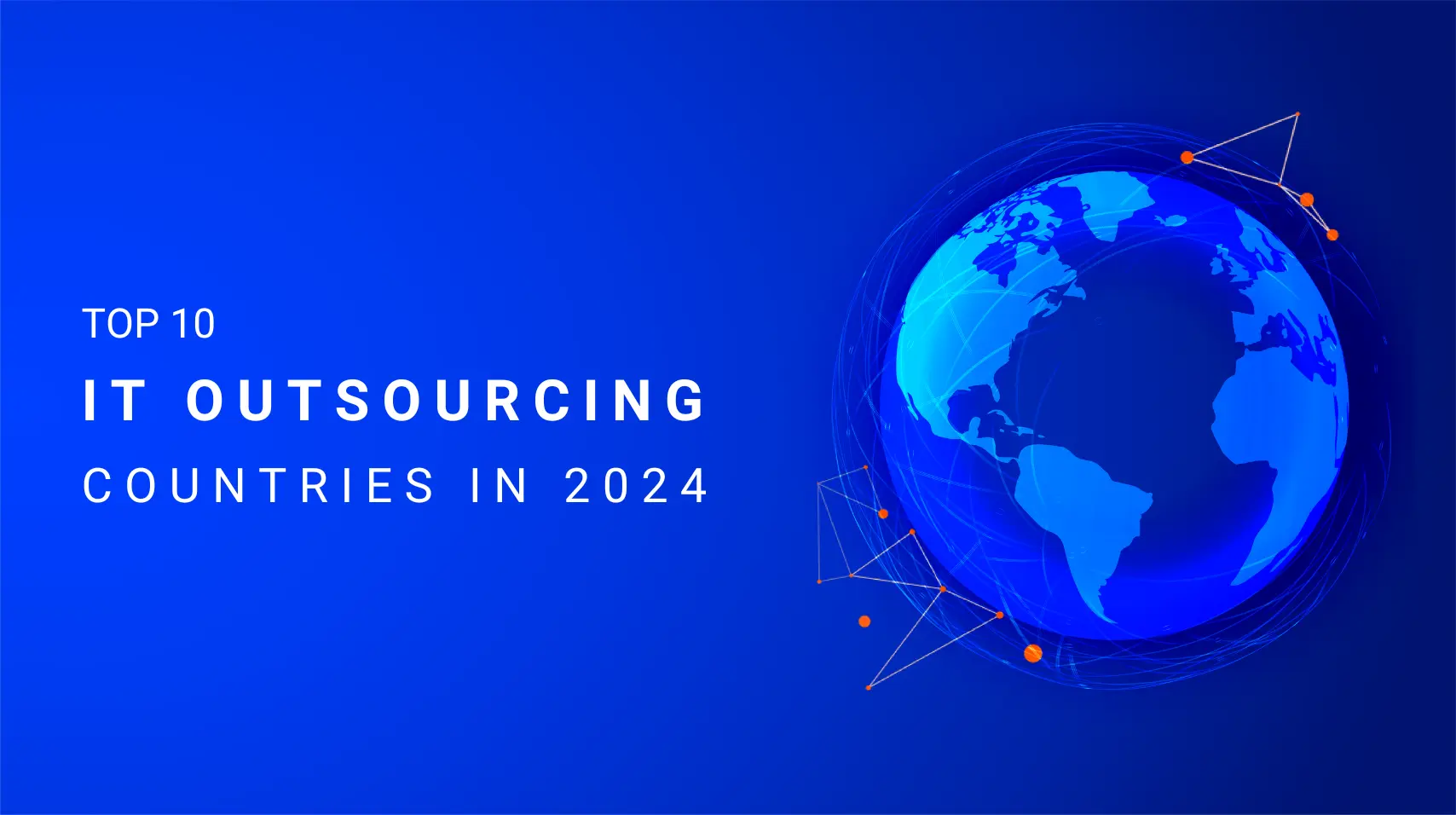
Top 10 IT Outsourcing Countries In 2024
With the economic challenges post-COVID-19, IT outsourcing has become a go-to solution for businesses aiming to use their budgets effectively. They’re partnering with outsourcing companies for IT tasks instead of solely depending on in-house teams.
Meanwhile, the IT sector is rapidly growing, fueled by ongoing tech advancements. Outsourcing is crucial to this growth, which is expected to soar to USD 525.2 billion by 2030, growing at a CAGR of 9.4% from 2023 to 2030. This points to a sustained high demand for IT outsourcing well into the decade.
When considering outsourcing software tasks, it’s crucial to identify the best countries for the job. The ideal locations are those that excel in technological expertise, offer favorable business environments, lead in innovation, and have strong English language proficiency. The following list will highlight the top 10 countries with stand-out IT dedicated teams that could be considered prime choices for IT outsourcing services.
1. India
India has consistently been at the forefront of the outsourcing sector and is renowned for its extensive pool of IT and software development talent. The country’s cost-effective services, proficiency in English, and solid tech infrastructure have established it as a preferred choice for global businesses. With more than 1.5 million IT graduates each year, India ensures a continuous influx of skilled professionals to satisfy the increasing demands of the outsourcing market in Asia.
Moreover, India’s cost structure is generally more affordable than Western countries, making it an attractive option for companies looking to outsource development tasks. For instance, according to Upwork, software developers in India typically charge between $18 and $39 per hour, which is significantly lower than the $50 to $60 per hour rate in the United States or Germany, with the average rate from $150 to $250 per hour. This combination of a large, skilled workforce and competitive pricing positions India favorably against other leading IT outsourcing destinations.
2. China
Just like India, China’s massive talent pool and diverse skill set make it one of the best countries for outsourcing, and it has emerged as an IT outsourcing power dominating the labor market. With an education system that promotes Math and Science, China provides some of the world’s best technology and IT services.
In terms of talent pool, China is one of the largest producers of IT graduates worldwide, boasting over 3 million IT graduates a year (this number is quite significant compared to India due to its large population). This vast number of highly educated and skilled individuals further solidifies China’s position as a desirable destination for outsourcing.
Additionally, the Chinese government actively supports IT development and invests in education to build a strong talent base. It focuses on advancing STEM (science, technology, engineering, and mathematics) education, which is essential for the IT sector. This approach improves learning in science and math, which is foundational for IT expertise.
In 2024, China remains a competitive choice for outsourcing, with an average IT outsourcing salary of about $20-$45 an hour, striking a balance between cost-effectiveness and quality output. This affordable rate and the country’s commitment to technological advancement make China an appealing choice for businesses worldwide.
3. Philippines
The Philippines is a sought-after hub for software development outsourcing and BPO is favored for its cost-effective labor and proficient workforce. English is the official language, simplifying communication and aligning with the country’s strong cultural connections to the US. This understanding of Western work culture is a significant advantage, especially since 94% of the population speaks English.
With around 190,000 developers stationed in key BPO centres like Manila, Cebu, Davao, and Bacolod, the Philippines is recognized as a leading IT outsourcing hub, especially in the healthcare and fintech sectors.
The educational system in the Philippines annually produces approximately 200,000 IT graduates, emphasizing IT and technical skills to create an adaptable and globally competitive workforce. In 2024, the average IT outsourcing salary stood at around $20-$60 an hour, affirming the Philippines’ position as one of the most economical offshore outsourcing destinations.
4. Brazil
Similar to the Philippines, Brazil shares cultural affinities with the US, which translates into high-quality IT services at competitive rates. This cultural resonance, coupled with its strategic location, makes Brazil a preferred partner for North American IT firms.
Brazil’s commitment to building a skilled tech workforce is reflected in the production of about 150,000 IT graduates each year. The government’s efforts to perfect the technological education infrastructure set Brazil apart as a top destination for offshore software development.
Although Brazil’s outsourcing costs are slightly high, with the average IT outsourcing salary at approximately $20-$50 an hour and an annual software engineer salary of around $12,000, it remains a competitive market. The country’s youthful population, 38% of which are young, positions Brazil as an ideal locale for hiring junior developers, underlining its robust and skilled tech workforce.
5. Vietnam
Vietnam is advancing as a notable destination for IT outsourcing, backed by a vast pool of skilled IT professionals. The country’s educational system, with over 300 IT-focused universities and centres, produces around 57,000 IT graduates each year. The Vietnamese government’s dedication to the IT sector is evident through supportive policies and incentives, contributing to Vietnam’s ranking within the top 50 digital nations.
The IT outsourcing market in Vietnam is forecasted to reach $698.90 million in revenue in 2024, with an anticipated annual growth rate of 16.38%, leading to a market volume of $1,282.00 million by 2028. The enterprise software segment is expected to achieve a market size of $247.3 million by the end of 2024. Moreover, the average spend per IT outsourcing employee is projected to be $11.80 an hour in 2024. These figures highlight a dynamic IT outsourcing market with an outstanding IT dedicated team in Vietnam, with growing employment and increasing value per employee, reflecting the nation’s investment in education and technological infrastructure.
6. Poland
Poland is a standout choice for IT outsourcing within Europe. Its central position in Europe and EU membership and a strong pool of software engineering talent make it an attractive base for businesses looking to grow in the European market.
The country’s IT industry is well-developed and supported by numerous universities that provide computer science education. Recent reports indicate that there are between 63,000 and 78,000 students enrolled in IT and ICT degree programs, with an annual graduation rate of about 10,500 to 13,500.
A significant draw for the IT Outsourcing market in Poland is the cost-effective yet highly skilled workforce, which is more affordable than in many other European nations. The cost for offshore software development services in Poland typically ranges from $40 to $56 per hour, depending on the project. This positions Poland as one of the leading Eastern European countries for cost-efficient programming expertise.
7. Malaysia
Malaysia is gaining traction in the IT outsourcing industry due to its cost-effective solutions and skilled workforce. Over 60% of Malaysians speak English, which, along with strong government support, makes the country an appealing outsourcing destination.
Annually, Malaysia produces around 100,000 IT graduates, reflecting its commitment to digital skills development. The government bolsters this with initiatives like tax incentives and funding for R&D.
In Malaysia’s tech sector, the average monthly salary is about $3,500, with an hourly rate of $14. These rates are lower than in the US or Western Europe. Moreover, a key development in Malaysia’s IT outsourcing is the growth of cloud computing and mobile app development. IT firms are investing in these technologies to offer better and more cost-effective services.
8. Argentina
Argentina’s IT industry is attractive to US and European clients due to English proficiency, cultural similarities, and time zone alignment. Competitive pricing and a highly skilled workforce add to its appeal. Web developers’ costs vary from $20 to $60 per hour, or around $14,100 yearly, based on experience.
With over 115,000 developers, many from top universities, Argentina’s education quality is evident. The country’s 2023 QS World University Rankings featured over 40 renowned computer science programs, 14 of which are in Buenos Aires, ensuring well-educated IT professionals.
9. Egypt
Egypt’s rise in the IT outsourcing market is attributed to its skilled workforce and cost-competitive services. The country’s low labor costs, combined with a large pool of engineering and development talent, make it a lucrative option for companies seeking IT outsourcing services.
The average hourly rate for IT outsourcing in Egypt in 2024 was between $25 and $50, presenting a budget-friendly choice for businesses. The ITIDA reports that an IT professional’s average annual salary in Egypt is about $10,000, significantly below the global average of $45,000.
Egypt’s educational system contributes around 50,000 IT graduates each year to the industry, ensuring a steady supply of technically skilled professionals. The Egyptian government is proactively enhancing the IT sector by offering incentives and training to expand the talent pool. This initiative is expected to grow the industry significantly.
10. Mexico
Mexico’s IT Outsourcing market is attractive for several reasons, including cost savings, access to a pool of skilled talent, and the ability to quickly scale operations.
In 2024, the average hourly rate for IT outsourcing in Mexico was estimated to be between $20 and $40. While this rate is slightly higher than some other outsourcing destinations, it is balanced by the advantages of geographical closeness, time zone compatibility with the US, and a deep understanding of Western business practices.
Mexico’s higher education system is on par with that of the United States and Europe, contributing to the supply of skilled IT professionals, with approximately 120,000 IT graduates produced annually.
The Mexican IT Outsourcing industry has seen steady growth over the past decade and is currently ranked as the fourth-largest IT outsourcing destination in Latin America. The industry’s expansion is expected to continue, driven by increasing demand for services such as software development, data analytics, and cloud computing.
To Sum Up!
The IT outsourcing market in 2024 is a strategic asset for businesses aiming to innovate and grow. It offers cost-effective access to skilled talent, driving operational efficiency and competitive advantage. Outsourcing is no longer just an option; it’s a strategic necessity that allows companies to focus on core competencies while outsourcing non-core activities to experts worldwide.
At Secomm, we can provide you with the best of our IT dedicated team, who have more than 10 years of experience in the IT sector. Feel free to contact SECOMM or call our hotline at (+84) 28 7108 9908 to ensure that your IT operations are handled by top-tier talent, fostering innovation and propelling your business forward.
 2
2

 655
655

 0
0

 1
1
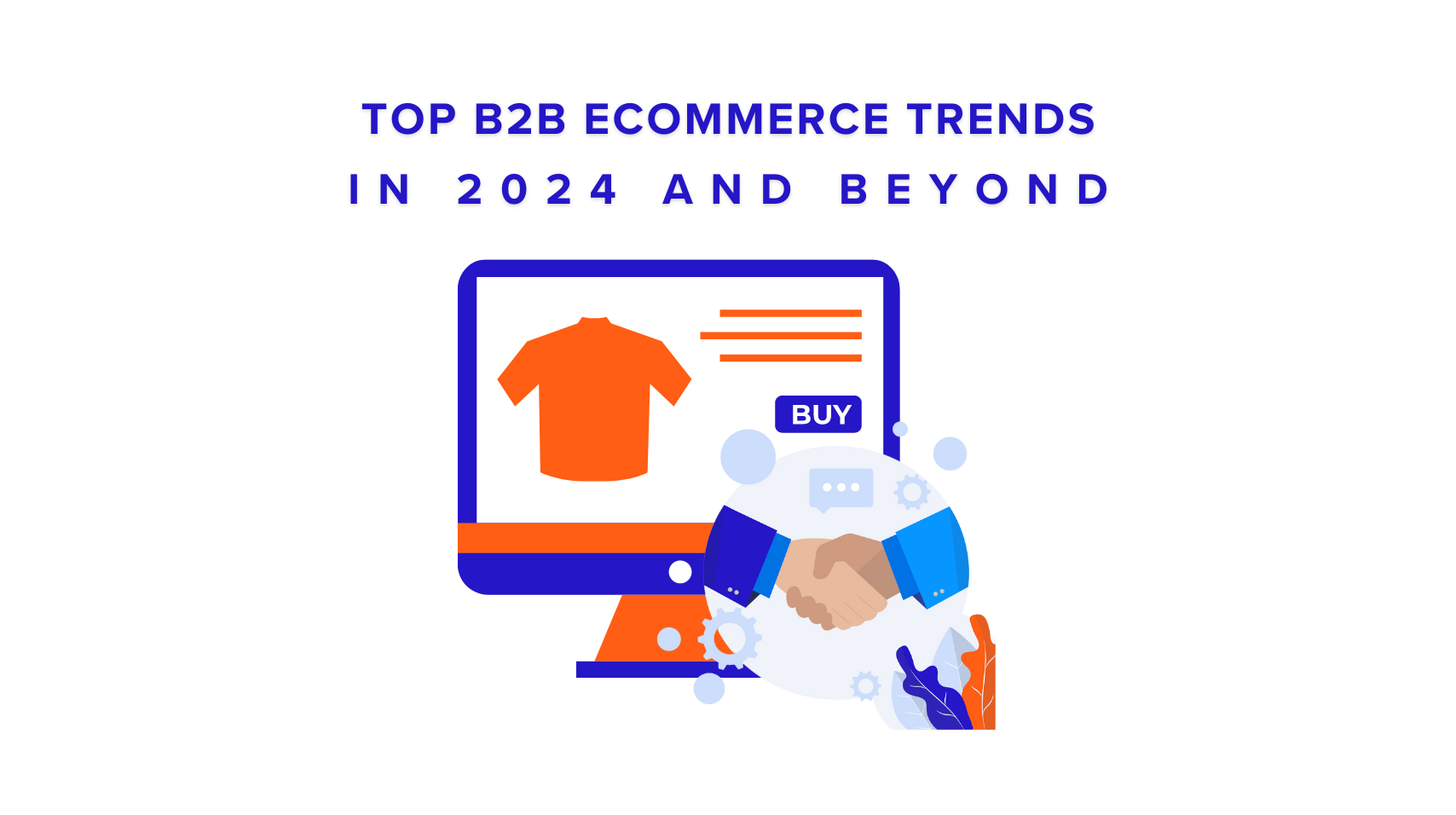
THE NEXT WAVE: B2B ECOMMERCE TRENDS BEYOND 2024
In the current B2B market, buyers are becoming more tech-savvy, mirroring the independent purchasing patterns of B2C consumers. This shift is driven by the changing demographics of B2B buyers, with 64% being Millennials and Gen Z, according to Forrester. Moreover, Gartner notes that 44% of Millennials prefer to make purchases without the involvement of sales representatives.
As a result, B2B eCommerce trends are rapidly evolving, influenced by both consumer behavior and technological progress. The increasing integration of generative AI into eCommerce, and the merging of online and offline experiences, are all pivotal trends. Keeping pace with these developments is essential; otherwise, businesses risk lagging in the fiercely competitive B2B eCommerce landscape.
In this article, let’s explore the top 8 B2B eCommerce trends that will shape the industry in 2024 and for many years to come.
1. AI For Personalized Customer Experiences
AI is making big strides in online shopping. AI chatbots are now a key part of customer service, offering personalized assistance and product suggestions. For example, Shopify Magic has AI tools that help create content and provide tailored shopping advice.
Chatbots are widespread, with over 1.4 billion people interacting with these AI systems worldwide. Retailers who have adopted AI have seen a significant increase in sales. It’s predicted that by 2027, 80% of retail leaders will use AI to enhance efficiency in their operations.
Beyond retail, AI is set to make a major impact on the economy. PwC estimates that AI could contribute as much as $15.7 trillion to the global GDP by 2030, affecting many industries.
2. Utilize Tools & Features For Workflow Automation
Businesses are increasingly turning to automation to improve efficiency without growing their teams. According to Markets and Markets, the marketing automation industry is expected to grow from USD 5.2 billion in 2022 to USD 9.5 billion by 2027, with a 12.8% yearly growth rate. Additionally, 57% of companies plan to use automation to make their employees more productive.
Shopify Flow is a tool that automates routine tasks for businesses. It activates specific actions based on rules set by the user, simplifying the workflow.
3. Embrace The B2B Omnichannel Model
With the rise of AI and automation, businesses are increasingly embracing an omnichannel strategy. This trend allows for seamless interaction across various channels, helping companies to be more budget-efficient in managing both their online and physical storefronts, ultimately enhancing customer satisfaction.
Data shows companies with robust omnichannel engagement retain 89% of customers, compared to 33% for those without. Additionally, 59% of consumers prefer self-research over interacting with sales-focused staff, highlighting the need for sales teams to prioritize customer guidance. Moreover, establishing a solid omnichannel base is essential, followed by streamlining all digital touchpoints for a unified and efficient customer journey. You can learn more on how to build an effective omnichannel strategy here.
Digital Touchpoints Need To Be Streamlined
In B2B e-commerce, the harmony of digital touchpoints is essential for delivering an exceptional customer experience and driving sales. Integrating all digital channels, such as payment systems, online stores, and customer support, is crucial. This integration provides a unified customer profile, streamlining management across multiple channels and focusing on omnichannel sales.
Streamlining transcends mere system connections; it ensures seamless data flow for personalized customer interactions. For instance, leveraging browsing habits for advertising and purchase history for customer service can develop comprehensive customer profiles.
Ultimately, streamlining is about fostering a consistent, reliable customer experience that bolsters brand interaction. Companies excelling in this are well-positioned for enduring success in the competitive B2B e-commerce market.
4. B2B Subscription eCommerce
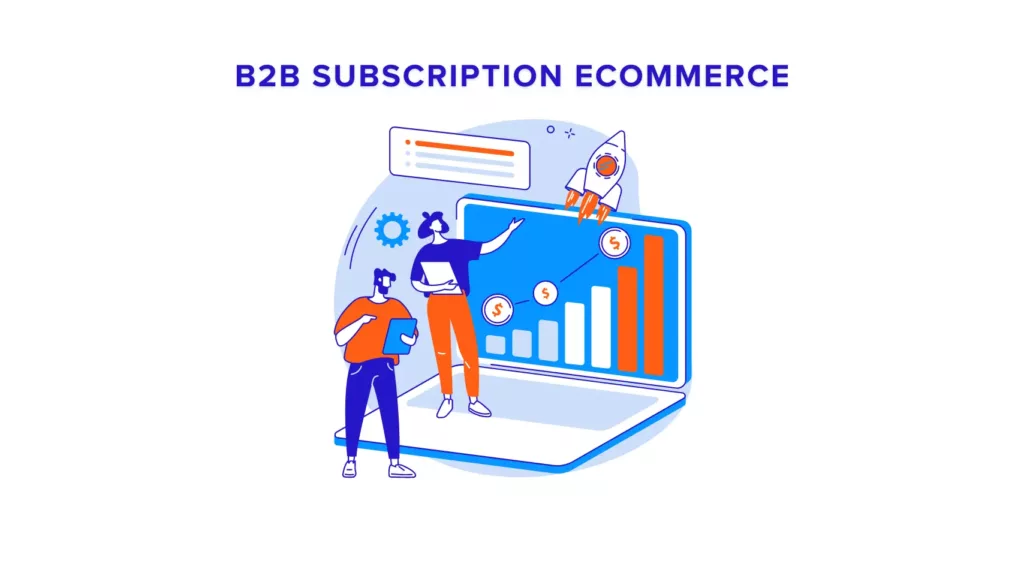
Subscription models are becoming vital for customer loyalty in B2B eCommerce, with the Global Subscription eCommerce Market expected to hit US$ 478 billion by 2025. These models offer a predictable revenue stream and deepen customer relationships beyond one-time sales. They cater to various business needs, from product supplies to software services. Moreover, as buying habits shift online, subscriptions align with customer preferences for self-services and problem-solving services.
Moreover, businesses often find that prioritizing the enhancement of the customer experience yields better results than constantly pursuing new leads. In the B2B sector, nurturing existing relationships and promoting additional purchases can be more profitable strategies than seeking out new customers. Find more about subscription eCommerce here.
5. Headless B2B eCommerce
Headless architecture is a way of building online stores where the front-end and back-end work separately but talk to each other through an API. This setup lets the back end hook up with any front end, making it perfect for businesses that sell across different channels.
Looking ahead to 2024, headless B2B eCommerce is on the rise. It’s not going to replace traditional eCommerce completely, but it gives businesses a leg up by being more adaptable, integrating better with other systems, scaling up easily, and making life easier for developers. All this leads to a better experience for business customers. The headless commerce market is booming; it’s expected to grow to $32.1 billion by 2027, with a yearly growth rate of 20.5%. You can find more information about headless eCommerce here.
6. Mobile Commerce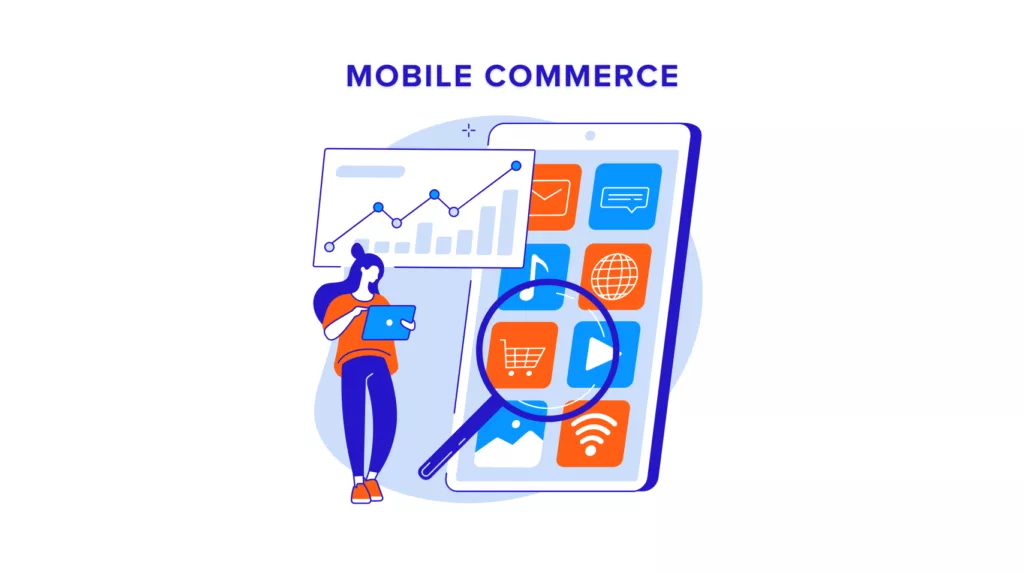
The trend of using mobile phones for online shopping is on the rise, primarily due to the advancements in online payment systems. This shift is attributed to the seamless buying experience provided by mobile commerce, where customers are quickly redirected to payment apps like MoMo or ZaloPay, offering a hassle-free transaction compared to traditional website payments that require them to pick up their phones for the payment process.
Furthermore, mobile devices are leading the charge in the B2B digital commerce evolution, with a significant majority of consumers preferring them over desktops and tablets. This growing preference underscores eCommerce platforms’ importance in crafting responsive and well-tuned mobile shopping experiences.
To leverage this trend, eCommerce sites need to go beyond mere mobile-friendliness and aim for mobile optimization. This involves designing interfaces that facilitate thumb-friendly navigation, expediting the checkout process, and ensuring swift site loading times. By concentrating on these aspects, eCommerce sites can become preferred shopping destinations, boosting online sales. In the realm of mobile commerce, the ease and speed of the shopping experience are directly proportional to the likelihood of completing a sale.
7. B2B Payment Innovations
The B2B eCommerce sector is rapidly adopting digital efficiency in payment processes. Automation and advanced digital transactions are replacing traditional methods, significantly reducing operational costs and manual labor. This modernization benefits both companies and customers, offering a more streamlined payment experience.
In the dynamic realm of B2B eCommerce, the transition from traditional payment methods to automated and advanced digital transactions is accelerating. A study by Markets and Markets highlighted that adopting automated payment systems can reduce operational costs for accounts receivable departments by 50% and cut down manual tasks by 85%. This evolution is beneficial not only for businesses but also for customers, who now have the convenience of making payments at their own pace, thus enhancing the overall payment experience.
Mobile Payments
The proliferation of mobile technology has revolutionized both shopping and payment behaviors. As smartphones become integral to the consumer journey, offering various payment options, including digital wallets like Apple Pay or Samsung Pay, has become essential. The year 2024 will mark a point where not accommodating such payment methods could be detrimental to customer retention.
Buy Now Pay Later
The ‘Buy Now, Pay Later’ (BNPL) model is emerging as a significant trend, particularly in Vietnam, where it’s a departure from the traditional installment payments. Platforms like Shopee are incorporating BNPL, indicating its potential to reshape the B2B payment landscape significantly.
In the US, Buy Now, Pay Later (BNPL) has won over more than a third of consumers recently, and it’s also gaining traction in Europe and Africa. This surge is tied to shifts in how people, particularly the younger crowd, prefer to manage their money, with BNPL’s flexible and wallet-friendly options being a hit. Gen Z is leading the BNPL charge, as they’re stepping into the workforce in big numbers. The trend shows that BNPL use among Gen Z is set to grow from 36.8% in 2021 to 47.4% by 2025. You can read more about BNPL here.
8. Augmented Reality (AR) in B2B eCommerce
Augmented Reality (AR) is transforming B2B eCommerce, turning simple spaces into interactive showrooms. With AR, businesses create 3D models that customers can explore in detail, offering an engaging experience far beyond what static images can provide.
Vietnam is riding the AR wave with remarkable vigor. The market is booming, with forecasts predicting a surge from US$96.4 million in 2023 to US$181.5 million by 2028, thanks to an impressive annual growth rate of 13.48%. AR is already a hit in children’s books and playgrounds, but it’s set to become a staple in our everyday lives, moving beyond novelty to become a standard in our daily routines, especially in the B2B eCommerce market, much like the memorable Oreo campaign during Tet 2020.

Wrap Things Up!
B2B eCommerce is booming, outpacing traditional stores. This surge is driven by digital advances and the economic shift after the pandemic. It’s not just a change; it’s a new online business era, where tech innovations benefit both shoppers and companies.
Navigating the digital marketplace can be complex, but you don’t have to do it alone. With a solid decade of crafting B2B eCommerce solutions, SECOMM is here to support your business’s growth journey. Feel free to contact SECOMM or call our hotline at (+84) 28 7108 9908 to discover solutions that align with the latest trends and propel your business forward.
 2
2

 643
643

 0
0

 1
1
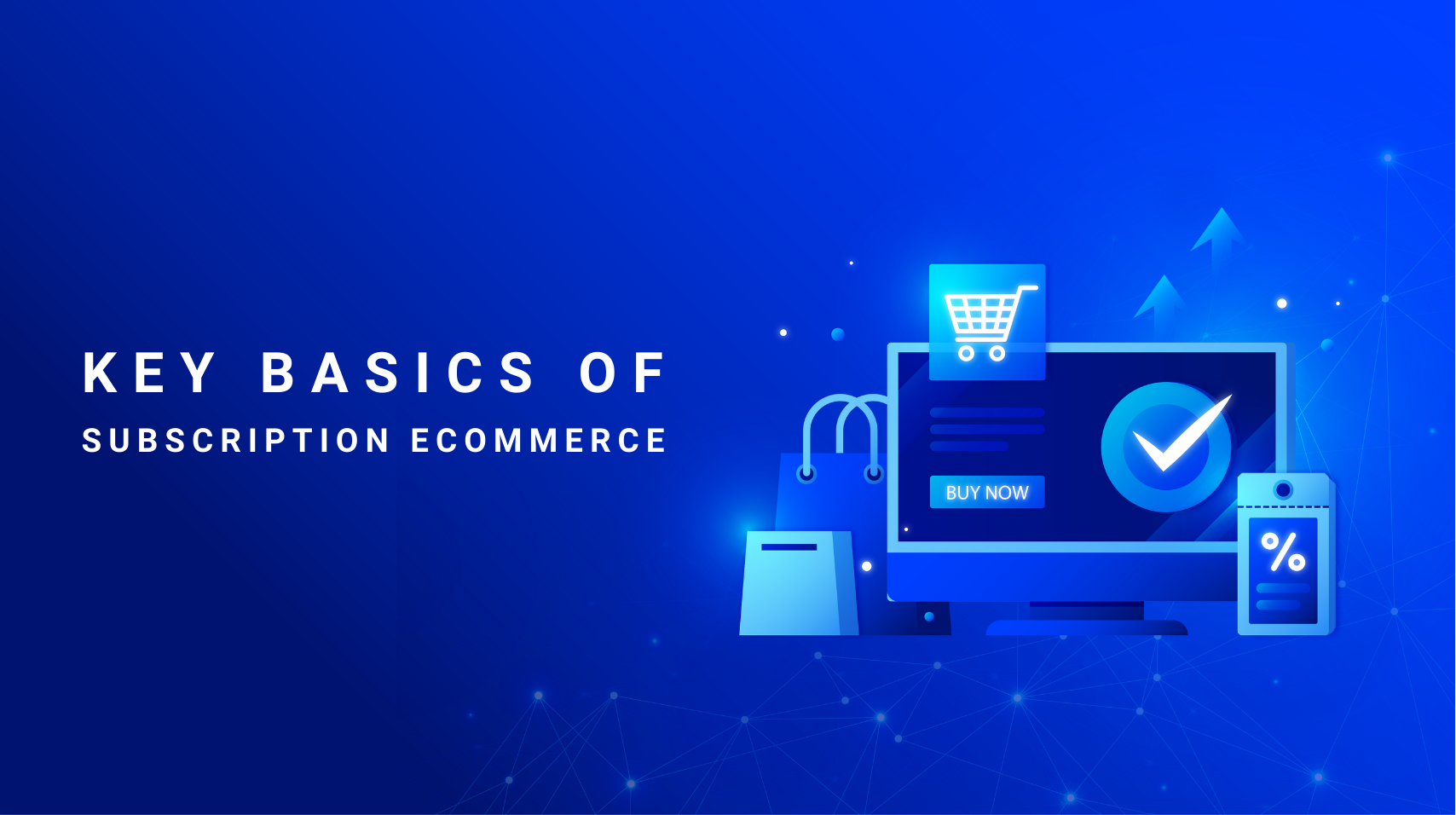
KEY BASICS OF SUBSCRIPTION ECOMMERCE
Subscription-based eCommerce, while not a novel concept, is increasingly being adopted in tangible forms, preserving its inherent value. Consider, for instance, the scenario of launching a seafood restaurant. You enter into an arrangement with a seafood supplier who commits to delivering fresh seafood daily.
This arrangement exemplifies a subscription model, which often includes perks such as discounts, promotional offers, or simply more favorable pricing compared to purchasing items individually from various suppliers.
If the concept still seems unclear, fear not! We’ll delve deeper into the mechanics of subscription eCommerce in the paragraphs below.
What Is Subscription eCommerce?
Subscription eCommerce is a business model where customers subscribe to receive regular deliveries of products or access to services over a specified period. Transactions are facilitated online, and customers continue to receive deliveries until they choose to cancel their subscription or until the agreed-upon subscription term concludes. Payments can be various, including one-time payments, periodic billing cycles, or automated payments.
In addition, there are several types of subscription-based online shopping, but in this blog, we will mention three common types. The first one is product or service subscriptions in which customers will receive annual product delivery or service access like gym memberships, daily grocery goods, etc.
The second one is the membership program, which is quite similar to most people. A good example of this could be “Hoi Cam” from Guardian, where customers can get exclusive discounts and a lot of benefits when joining.
The third one might be familiar to many of you, which is called Software-as-a-Service (SaaS). For example, when using Microsoft 365 or Canva customers need to pay monthly or yearly to use all the functions of the tools and software. You can find more about SaaS here.
Additionally, the eCommerce subscriptions market seems to have risen steadily in recent years with the global market size reaching US$ 193.6 Billion in 2023. Moreover, this number is forecasted to reach US$ 5,014.4 Billion by 2032, showing a growth rate of 43.56% from 2024 to 2032.
From the information above, it prompts an important consideration: what are the tangible benefits and drawbacks for businesses when adopting eCommerce subscription programs? Assessing the impact of these programs is crucial for understanding their influence on operational dynamics and customer engagement.
The Benefits of The Subscription eCommerce Model for Businesses
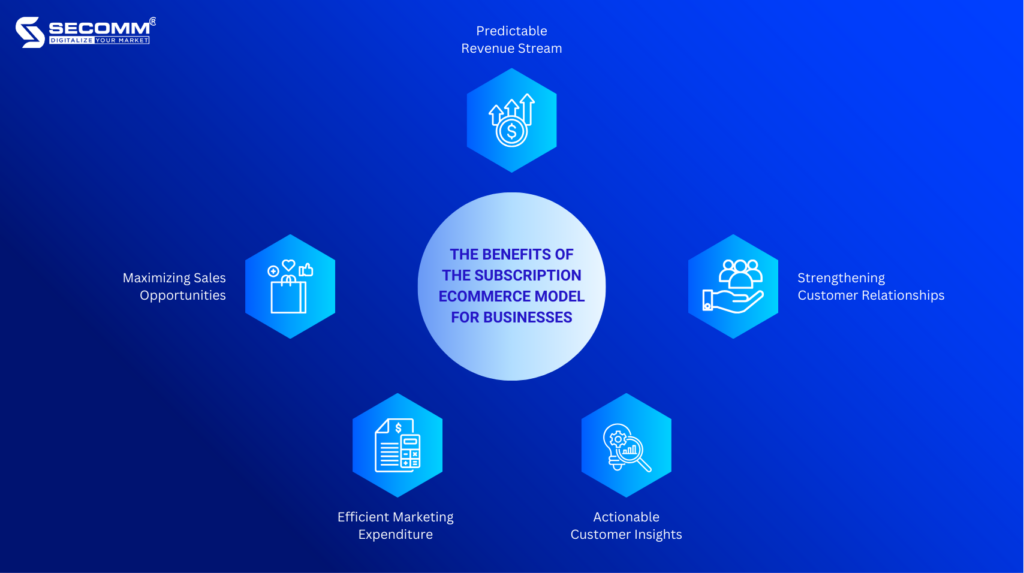
ECommerce subscription models aren’t just a trend; they are a strategic approach that offers businesses a plethora of benefits, from predictable revenue to deepening customer relationships.
Predictable Revenue Stream
Contrary to the unpredictable nature of one-time transactions, subscription models offer a steady revenue flow. This advantage enables your organization to formulate a comprehensive budget for marketing endeavors spanning an entire quarter or year, necessitating only slight adjustments. Essentially, businesses are equipped to more accurately project their financial trajectory by establishing a consistent subscriber base pledged to recurrent payments. This later helps enhance strategic planning and facilitate expansion prospects.
Strengthening Customer Relationships
Subscriptions are more than transactions; they are the foundation of a long-lasting relationship with customers. A study by Zuora highlights that 93% of subscribers believe companies should invest more in customer satisfaction. By adopting a subscription model, businesses are not merely selling a product—they are nurturing a connection that encourages customers to return, fostering loyalty and trust.
Actionable Customer Insights
Truly understanding customers goes beyond superficial interactions. It involves analyzing their behaviors and preferences over time. Subscription models are instrumental in gathering this data, offering insights into customer tendencies, shopping habits, and interests. This information is crucial for customizing products and services, enhancing marketing strategies, and identifying growth opportunities – all while potentially reducing market research costs.
Efficient Marketing Expenditure
Additionally, enterprises need to capitalize on the insights derived from their eCommerce subscription base to enhance marketing initiatives, rather than allowing this valuable data to remain underutilized. Armed with an in-depth understanding of customer predilections, companies are empowered to devise bespoke experiences that truly engage their clientele. This strategic personalization not only bolsters customer loyalty but also fortifies the company’s market position, diminishing the likelihood of customers exploring alternative options.
Maximizing Sales Opportunities
Subscribers typically exhibit greater loyalty and, as a result, have a propensity to increase their expenditure over time, which can significantly enhance a company’s profitability. Additionally, the subscription framework provides fertile ground for upselling and cross-selling strategies. Businesses can boost their average order value and realize extra revenue from their current subscribers by offering assorted subscription options or supplementary products and services. Take, for instance, a fitness establishment that could propose special offers on workout gear to its patrons, thereby establishing a reciprocal relationship where the customers benefit from the perceived value, and the business sees a rise in sales.
Crafting An Effective Subscription eCommerce Model
Understanding the purpose and goals of your eCommerce subscription model is essential. Whether you’re targeting revenue growth, increased profitability, or business expansion, defining these objectives upfront will shape a successful strategy.
Simplifying The Subscription Process
Ease of subscription is crucial in the eCommerce industry. A straightforward and user-friendly sign-up process not only improves conversion rates but also increases the value perceived by customers, making them more likely to sign up.
To ensure optimal accessibility and ease of registration, it is crucial for eCommerce subscription services to be prominently featured and straightforward to navigate, thereby accommodating a broad digital audience. For instance, consider the “Hoi Cam” program by Guardian: the membership is subtly referenced via a brief mention in each social media post, rather than being highlighted in a dedicated post. Similarly, on their website, the registration option is relegated to a minor tab, devoid of any prominent banners to signal its presence.
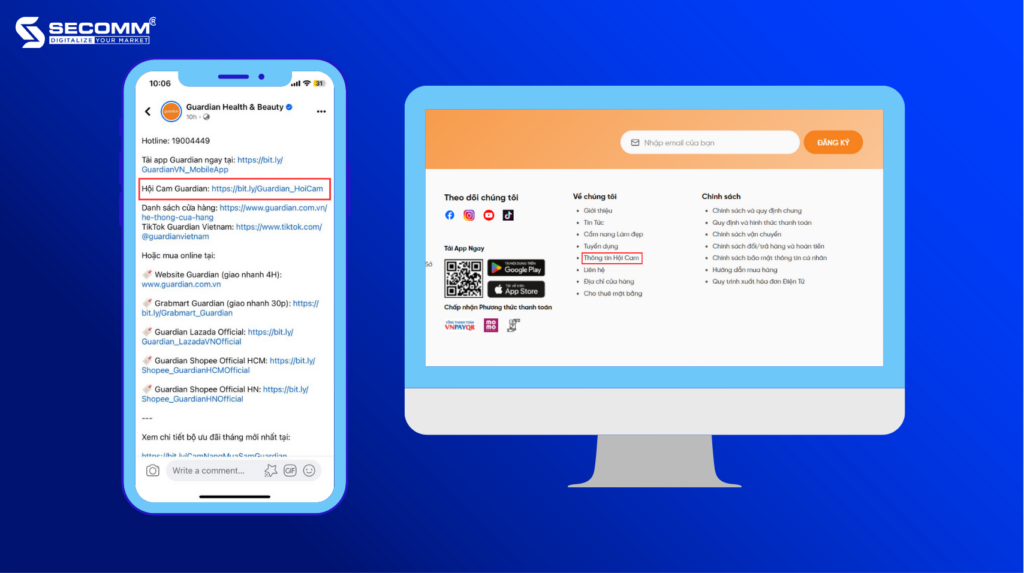
Even in physical outlets, the program is scarcely communicated by staff members. This approach necessitates that customers invest effort into seeking registration details, which could lead to frustration and a diminished user experience.
Fostering Customer Relationships
In the eCommerce subscription business, building strong customer relationships is crucial. It involves recognizing your customers’ importance. If customers don’t see the value, they may feel overlooked and undervalued, and consider other options. So, it’s important to grow loyalty and strengthen these bonds over time. Remember, when your service team consistently provides excellent support, customers will trust your brand more, which is key when they decide to renew their subscription.
Also, developing detailed customer personas is helpful. Knowing your customers’ preferences, habits, and spending limits helps you tailor your services to fit their needs, keeping them engaged and happy. When customers notice that you care about their preferences, they’re more likely to stay loyal and not switch to another business.
Balancing Pricing with Customer Satisfaction
Your pricing strategy should reflect your product/service type, business objectives, and customer personas. Starting with a basic package covering essential services is advisable if you’re unsure of customer preferences. This approach allows you to launch your service while remaining adaptable. As you gather customer feedback and preferences, you can adjust your packages to suit different customer segments, ensuring your offerings evolve to meet customer demands effectively.
Challenges for Applying Subscription eCommerce Model
When implementing a subscription-based eCommerce model, it’s crucial to be aware of potential pitfalls to ensure seamless business operations.
Customer Engagement
The key to a successful subscription model is maintaining long-term subscriber engagement. Incorporate personalized elements, exclusive content, and loyalty rewards to make subscribers feel valued. Moreover, you could highlight the unique benefits your service offers over competitors to discourage churn.
For new subscribers, businesses need to simplify the sign-up and showcase their services’ value straightforwardly to reduce the likelihood of early drop-offs.
Inventory Management
If your business involves physical goods, managing inventory against customer demand is critical. Monitor customer preferences closely and adjust inventory accordingly. Always have a contingency plan for supply chain disruptions to maintain consistent product availability.
Scaling Infrastructure
As your subscriber base expands, the complexity of your infrastructure must evolve accordingly. Consider the user experience – a seamless service is expected, particularly for digital offerings akin to Canva. Your infrastructure should be robust enough to handle a spike in users without compromising performance.
Is everything making sense so far? Before we conclude today’s session, let’s examine the following case study for a practical understanding.
A Case Study from Amazon
Amazon Prime serves as an exemplary model of subscription eCommerce success, offering a suite of benefits that extend well beyond swift shipping. Subscribers gain access to an array of advantages, such as complimentary two-day delivery, an extensive library of streaming content, and exclusive shopping deals. This service is not merely about rapid order fulfillment; it represents a continuous stream of value and convenience.
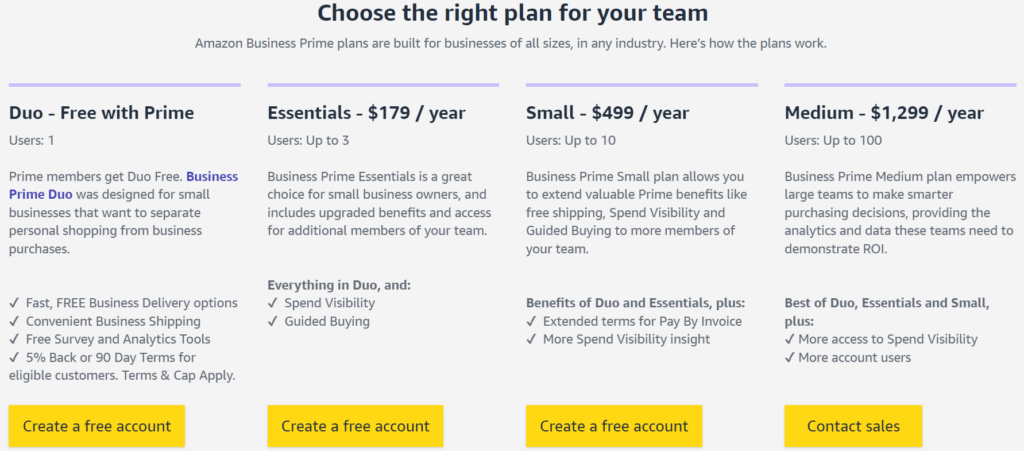
The distinctiveness of Amazon Prime lies in its amalgamation of various services into a single subscription package, which streamlines customer experience and fosters brand loyalty. The program’s expansion reflects Amazon’s dedication to customer satisfaction and its strategic addition of new perks, all while integrating seamlessly with the larger Amazon eCommerce ecosystem. This strategic bundling is a key factor in customer retention, positioning Amazon as a leader in the eCommerce sector.
To Wrap Ups!
Subscription eCommerce is a strategic approach adopted by numerous businesses, yet only a select few have truly harnessed its potential. This guide is designed to deepen your understanding and provide actionable insights to effectively utilize subscription eCommerce. For those ready to embark on this journey and in search of a trusted advisor, Secomm is your ideal partner. We offer end-to-end solutions to address all your eCommerce needs, from technical infrastructure to event management.
 2
2

 683
683

 0
0

 1
1



